- African Games
- Kwahu Paragliding
- Heritage Month
- #DecemberInGH
- Visit Ghana App
- Book City Tour
- Manhyia Palace Museum
- Kpetoe Agotime Kente Village
- Ntonso Adinkra
- Daboya Fugu
- Bonwire Kente Village
- Sirigu Pottery & Art
- Back To Village Food Bazaar
- Forts and Castles
- Kwame Nkrumah Memorial Park
- Cape Coast Castle
- Elmina Castle
- Komfo Anokye Sword Site
- Larabanga Mosque
- Bisa Aberwa Museum
- Assin Manso Slave River
- Nakore Mosque
- Paragliding Festival
- Kakum National Park
- Legon Botanical Gardens
- Aburi Quad Biking
- Mountain Afadja (Afadjato)
- Tafi-Atome Monkey Sanctuary
- Wli Waterfalls
- Lake Bosomtwi
- Nzulezu Village On Stilt
- Bunso Eco Park
- Bobiri Forest and Butterfly Sanctuary
- Wechiau Hippo Sanctuary and River Safari
- Asogli Yam Festival
- Odwira Festival
- Greater Accra
- Beyond The Return
- Year Of Return
- Travel Information
- Flight & Transport
- Ghana Gurus
- Directory Of Licensed Enterprises
- Travel & Tours
- Ghanaian Name
- GTA Services
- Back to Village Food Bazaar
- PANAFEST/Emancipation
- DecemberInGH
- Year of Return
- Latest News
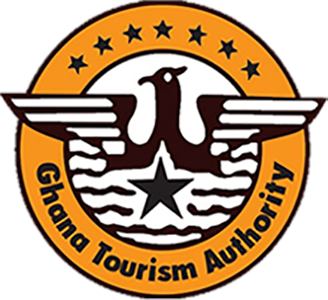

Dentaa-at-Tafi-Atome
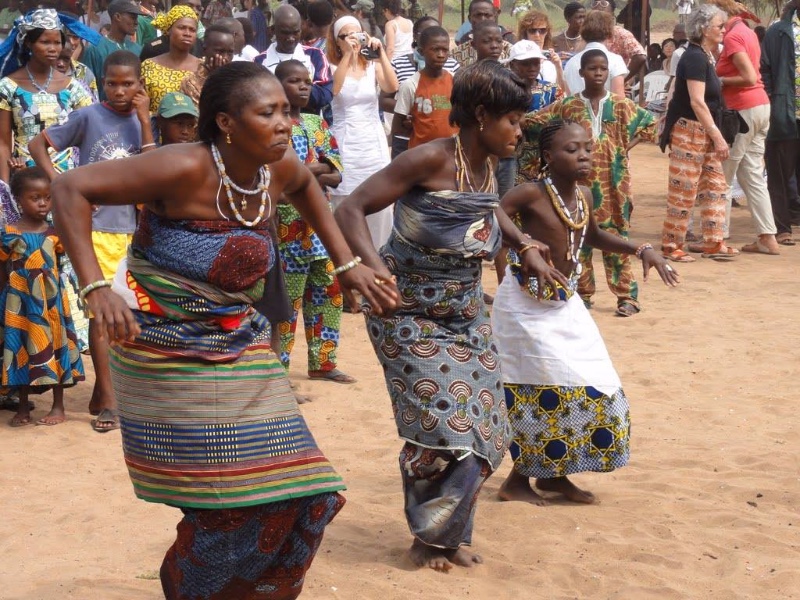
Lake_Volta_06
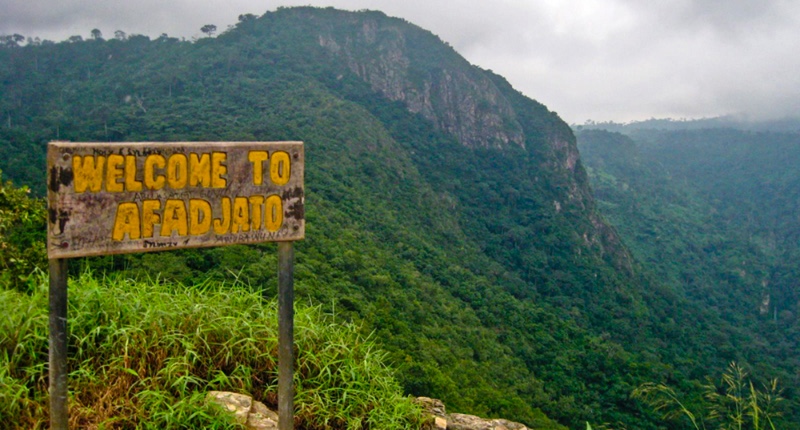
mountain-afadjato
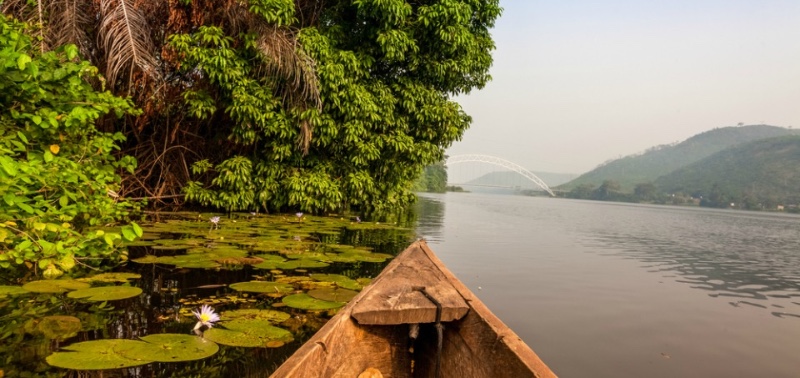
lake-volta-1
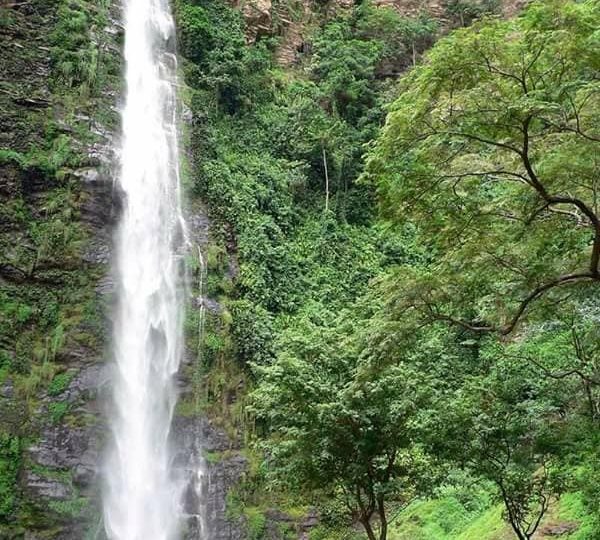
1996_wli-water-falls-600x540
About volta region.
The south-easterly region of Ghana is the Volta Region, an area of extraordinary scenic beauty bordered by the Volta lake to the east, Atlantic Ocean in the south, Togo to the west and the Oti region to the north. Its landscape of rolling hills and valleys, with rocky outcrops, lagoons, rivers and waterfalls, is one of nature’s most attractive gifts to Ghana.
Volta Region is one of Ghana ‘s sixteen administrative regions , with Ho designated as its capital. Divided into 25 administrative districts, the region is multi-ethnic and multilingual, including groups such as the Ewe , the Guan , and the Akan peoples. The Guan peoples include the Lolobi , Likpe , Akpafu , Buem , and Nkonya (now part of Oti region) people, et al. This region was carved out of the bigger Volta Region in December 2018
Climatic conditions vary tremendously within the Volta Region, which stretches from the coastal plains on the Atlantic coast to the arid lands of the north. Visitors can experience almost every tropical climate in West Africa as they travel from the coastal plains, fringed by sunny beaches and mangrove swamps, through the deciduous rain forests of the central belt- the location of Mount Afadjato the arid savanna of northern Ghana.
The west of the region is dominated by the River Volta and Lake Volta. The lake is a popular recreational area as well as providing a major source of power and water for the region and a ‘water highway’ to the north. Visitors can enjoy a music cruise along the lake or ride the river in a canoe with a local fisherman. The beaches of the Volta estuary are among the best in Ghana and swimming is popular in some areas, although the sea is generally rough along the Atlantic coast.
At resorts along the coast, visitors can see crocodiles and marine turtles, indulge in water sports, or try their hand at deep-sea fishing. Tourism hotspots include the amazing Wli Falls , one of the highest waterfalls in Ghana, in the tropical forest near Hohoe. Equally spectacular are the nearby Tsatsadu falls at Alavanyo and the Tagbo falls at Liate Wote.
Kente cloth, traditionally woven by members of the Ewe and Ashanti tribes, is one of Ghana’s most famous exports. Over 90 percent of the population are Ewe, the largest ethnic group in the region. The Ewe migrated from the north and their weaving villages can be found along the path of migration. Ewe kente cloth is distinguished by bold animal, human and symbolic patterns skilfully woven into bright cloth. Both groups excel at weaving cloth fit for a king and originally kente was only worn by Kings, Chiefs and prominent people. Now, it is available to all, but because of its relatively high cost, it is still a cloth of prestige, worn on important religious and social occasions. Kpetoe is one of the popular places for the weaving of Kente.
Ho, the region’s capital, is an ideal place to learn about Ghana’s heritage. The ruins of European forts and other structures can still be seen, with unmistakable vestiges of the German colonial era. Visitors can find out more about the area’s history by visiting the regionals museum.
Scenic Flow of Nature
The Volta Region is a lush, highland area full of spectacular natural attractions, scarcely visited coasts and beaches, clear rivers, botanical gardens, and beautiful waterfalls. Visitors can take a trip to the cities of Ho and Hohoe or take the opportunity to see mountains, monkey sanctuaries, and kente weaving villages. The Volta Region gives the visitor a chance to truly appreciate the magnificence of the Ghanaian way of life.
The region is a blend of undulating highlands and lowlands with very lash green vegetation. It boasts of the newly created Kyabobo National Park which is in the Nkwanta district of the northern Volta (Oti) Region, 400 km from Accra. the 359 sq km park contains both forest and savanna species of plants and animals. Animals in the park include buffalo, kob, warthog, aardvark, and baboon. Threatened species include lion, elephant, bongo, reedbuck and hartebeest. With its rich fauna and scenic beauty, Kyabobo National Park is set to boost the tourism potential of the Volta Region once fully developed.
The predominant languate of the volta Region is Ewe which strangely has different dialets as one travels acrosss the region. Also in the region is the Adele, Gikyode, Buem, Ntrubo and Chumburung.
The Volta Region is renowned for its bright festivals and loud ceremonies. The people of Wli hold a unique festival to give thanks for the gift of water, whiles the Anlos people put on the illustrious Hogbetsotso festival ( the name is derived from the Ewe language and translates as ‘festival of Exodus’). A purification ceremony takes place on the first Saturday in November and is followed by several days of cleaning the villages, sweeping the streets, and burning of rubbish. At the climax of the festival, local people do the traditional Borborbor dance, while chiefs dress in colourful regalia and receive homage from their subjects. The joyous dancing and singing that characterize the Volta festivals is a reminder of the region’s rich diversity of history and tribal culture.
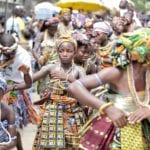
1. The Anlo Hogbetsotso Festival
A weeklong festival climaxing on the first Saturday of every November, a grand durbar of chiefs and people is held at Anloga, the traditional home of the Anlo–speaking Ewes. The durbar forms a significant part of the week–long Hogbetsotso festival which commemorates the migration of the Anlo – Ewes from the ancient walled city of Notsie in present day Northern Togo to their present settlement. The festival culminated in drumming and dancing to “Husago” by walking “backwards” which they claimed was to elude their enemies who might follow them after they had escaped the tyranny of the wicked King Agorkoli.
2. Asogli Yam Festival (Teduduza) Of The People Of Ho
September each year, the chiefs and people of Asogli State, Ho and its environs celebrate their annual yam festival. This is essentially a harvest festival celebrated to give thanks to God, the lesser gods and ancestors for a bumper harvest. It is an occasion to offer prayers for good health throughout the year, prosperity for all and to foster unity through forgiveness and reconciliation. As part of the celebration, cooked mashed yam is sprinkled at the various shrines across the state. After the gods are fed, everyone is then permitted to taste the fresh yams. There is usually a grand durbar of chiefs where the Paramount chief (Togbe Afede XIV) sits in state to receive homage from his sub-chiefs. The festival serves as an annual re-affirmation of allegiance by all chiefs and their subjects in the Asogli State to the Agbogbome stool.
3. Keta – Sometutuza
This is celebrated two weeks after the Anlo – Ewes celebrate Hogbetsotso festival (weeklong festival climaxing on the first Saturday of November), their cousins, the same Ewes celebrate their Keta – Sometutuza at Agbozume, their traditional home. This colorful festival of pomp and pageantry is rounded off with a grand durbar of chiefs and their subjects on a Saturday. Chiefs pay homage to their paramount chief and renew their allegiance.
4. Amu (Rice) Festival Of The People Of Vane
As the name implies, the festival is centered on the harvesting of rice so it is a harvest festival. It is celebrated at Vane , the Traditional capital of the Avatime people. It is celebrated in the last week of November to December. It attracts a number of tourists. The people of Avatime, who migrated from the Ahanta areas of the Western Region, fought the original people of the area they now occupy, and this is reflected in their drumming, dancing and singing.
5. Dzawuwu Festival Of Agave
Every February, the chiefs and people of the Agave traditional area celebrate their annual Dzawuwu festival at Dabala, their commercial centre. It is essentially a thanksgiving festival where a special portion of food is sprinkled to the gods. It also commemorates the bravery of the Agaves of the past who fought and won several wars. It is the time to pay tribute to departed ones and to pour libation for the people to renew their loyalty to their rulers. It has an impressive Durbar of chiefs to climax it. Drumming and dancing feature prominently.
6. Gbidukor Festival Of The Gbi
November is when the chiefs of Gbi (North) of Hohoe areas and Gbi (South) Peki areas celebrate their festival. This festival rotates from Hohoe to Peki. It is a very colourful festival full of pomp and pageantry. Chiefs are carried in palanquins amidst drumming and dancing. The festival is to commemorate the exploits of the Gbi-Ewes of old. New development projects are initiated. It also marks the period of family re-union and to attract thousands of people from far and near.
Attractions
- Amedzofe Village
- Tagbo Falls
- Snake Village, Liati Wote
- Tsatsadu falls
- Mountain Afadja (Afadjato)
- Tafi Atome Monkey Sanctuary and Cultural Village
- Kyabobo National Park
- Kpetoe Kente Weaving Village
- Avu- Lagoon Xavi
- Fort Prinzenstein
- Ancestral Caves of Leklebi
- Kalakpa Game Production Reserve
- Atorkor Slave Market
- Cape St Paul Lighthouse
For more information, visit our volta Region Website
Leave a Review Cancel reply
This site uses Akismet to reduce spam. Learn how your comment data is processed .
Sorry, no activities highlighted. Kindly share your thrills in the review section. Thank you.
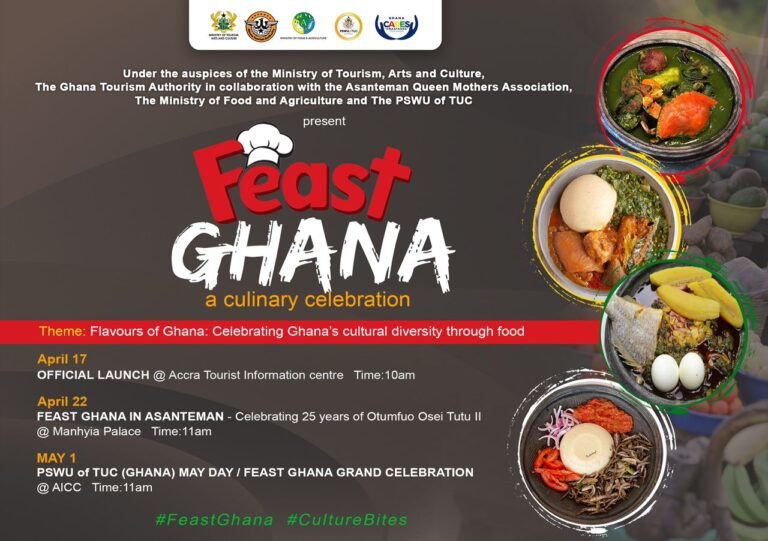
Feast Ghana
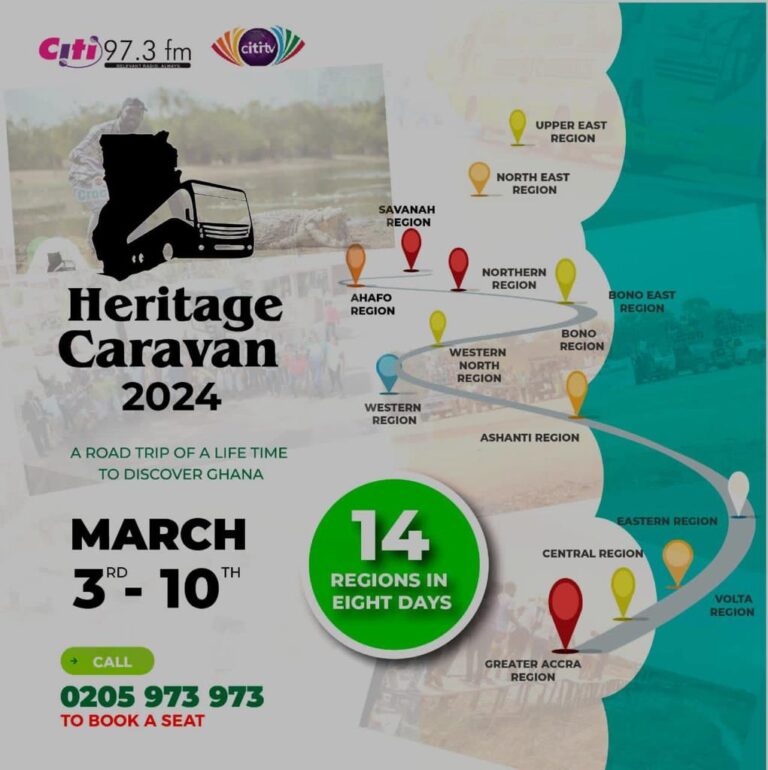
Heritage Caravan
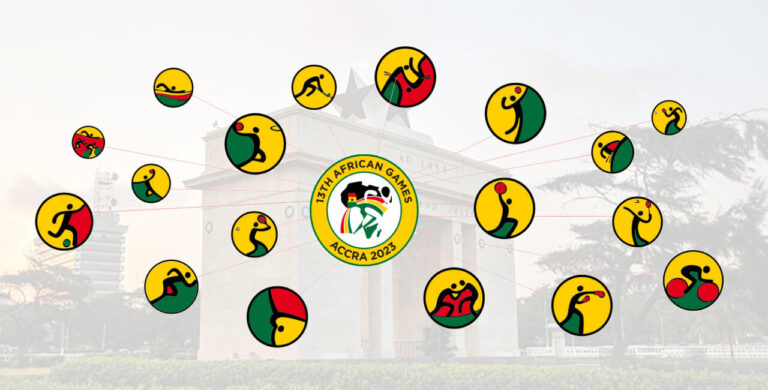
13th African Games, Accra 2023
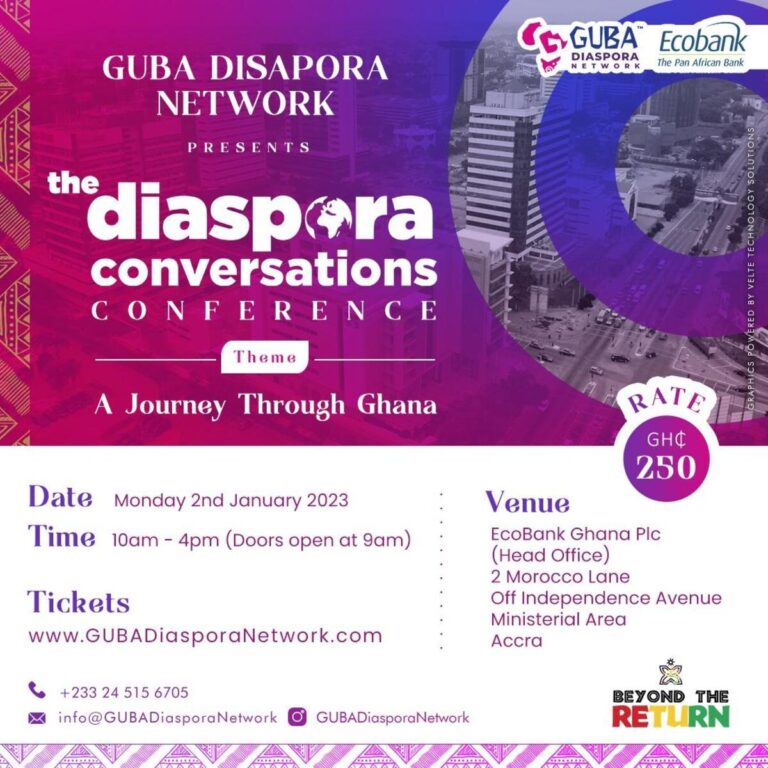
The Diaspora Conversations Conference
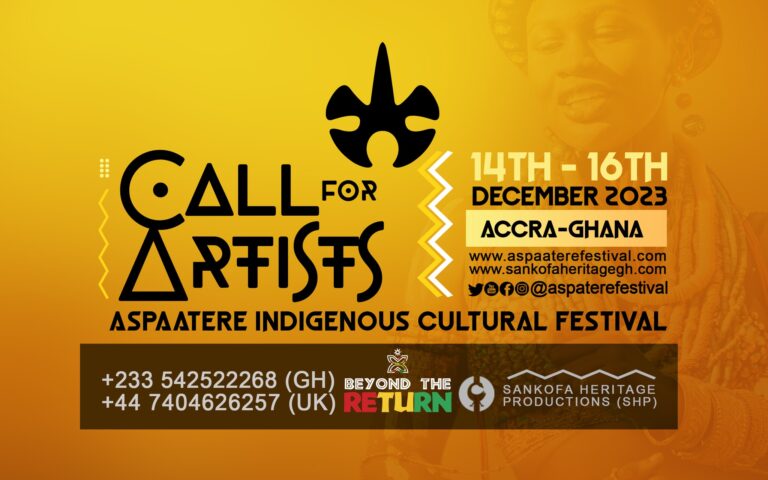
Aspaatere Indigieous Cultural Festival
- History of Ghana
Visas & Diplomatic Missions
- Travel Tips
- Where To Stay
- Food & Dining
- Highlights by Region
- Culture & Heritage
Festivals in Ghana
- Forts & Castles
- Handicrafts
- Top Attractions
- Special Events
- Accommodation
- Tour Operators

Volta Region
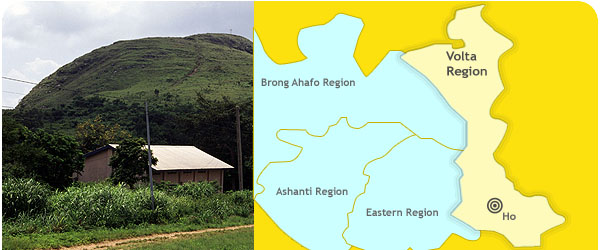
The most easterly region of Ghana, bordering on Togo, the Volta Region is an area of extraordinary scenic beauty. The rolling hills and valleys, rocky outcrops overlooking Lake Volta, and lagoons, rivers and waterfall make for one of nature’s most attractive gift to Ghana. The region stretches from the coastal plains on the Atlantic coast right up to the arid lands of the north, and climatic conditions can vary tremendously. From the coastal plain, fringed by sun-dappled beaches and mangrove swamps, through moist deciduous rain forests in the central belt, where Mt. Afadjato at 885m is the highest point in Ghana, to the arid savannah of northern Ghana, you can experience almost every tropical climate in West Africa.
This region is also dominated by the River Volta and Lake Volta, on its western flank. The lake is a source of power, and much of the water for the region; it is the water highway to the north, a great fishing lake as well as a popular recreational area.
The festivals and ceremonies reflect the rich diversity of history and culture of tribal life in the region. The relics of European coastal forts and other structures still remain, while further north vestiges of the German colonial era are unmistakable. The regional museum at Ho is an ideal place to understand the background to our heritage.
Hohoe is an important centre of herbal medicine, which is of significant and growing importance both in Ghana and the western world today.
Discover the Wli Waterfalls in the tropical forest near Hohoe, the highest in Ghana, or the nearby Tsatsadu Falls at Alavanyo, or the Tagbo Falls at Liate Wote which are almost as spectacular. Afadjato Mountain attracts climbers of all ages, while the Kalakpa Game Production Reserve is a special place for environmentalists.
Volta is famous for its festivals and ceremonies, of which the Hogbetsotso of the Anlos people in November is probably the most famous. The people of Wli have a unique festival to give thanks for the gift of water.
The main gateway from Togo is at Aflao, and hotels, guest houses and restaurants can be found in all the main centres, including Ho, Keta, Kpando and Hohoe.
The beaches of the Volta estuary are amongst the best in Ghana. Swimming is popular in some areas, although the sea is generally rough along the Atlantic coast. New hotels are providing facilities for waters ports and deep sea fishing. Tuna, tarpon and barracuda may be caught, and arrangements can be made in advance through the local hotels.
The region is located at the eastern part of Ghana, sharing its eastern boundary with the Republic of Togo, western with the Volta River and Lake. The southern border is the Atlantic Ocean, wile the north shares a boundary with the Northern Region.
THE MAIN ECONOMIC ACTIVITIES
The main economic activities are farming, fishing, animal rearing, petty commerce and tourism.
The people of the region are made up of Ewe, Adele, Nchumuru, Akpafu, Atwode, Lolbi, Tafi, Avatime and Akan. Others are Santrokofi, Nyagbo, Buem, Bowiri, Logba, Ga-Adangbe.
Attractions
Lake Volta Estuary The estuary is an area of great scenic beauty with river and ocean beaches, and picnic spots shaded by palm tree. The sand bars are the nesting grounds for sea birds, and endangered species of twitter are still found here.
The Keta-Angaw Lagoon Basin Important wetland and breeding ground for migratory birds
Tafi Monkey Village The sacred monkey sanctuaries around Tafi Atome, some 5kn away from the Avatime hills.
The Waterfalls of the Volta Region Although some may be seasonal, all are set in attractive wooded or mountain settings.
- Wli falls – 20km from Hohoe, in the Wli nature reserve
- Tagbo falls – Liate Wote
- Tsatsodu falls – 10km from Hohoe
- Aflambo falls –Leklebi
- Amedzofe – Abadzeme falls
Kalakpe Game Production Reserve At Abutia, 15km from ho, the reserve has increasing species of migratory and indigenous birds life, buck, buffalo and monkeys.
Kyabobo National Park A newly designated National Park in the foothill of Mt. Djbobo, on the border with Togo.
Grottos and Caves In the limestone hills, the grottos and caves are dramatic. Not to be missed are:
- The ancestral caves of Likpe – 14km form Hohoe
- The grottos of Kpando – Aghehoe and Aziavi
- The caves of Nyagbo and Logba
- Caves and iron mine workings – Alepafu
Historical Sites
- Fort Prinzenstein, Keta
- Cape St Paul Lighthouse, Woe
- German Historical Site at Kpando, Ho, Amedzofe, Kpedze.
Cultrual Festivals & Events
Hogbetsotso Festival The Anlo Ewes, an ethnic group on the eastern coast of Ghana, are believed to have settled in Notsie in Togo when they first migrated from Southern Sudan. Legend has it that they escaped from the tyrannical ruler of Notsie, Ago-Koli, by walking backwards. In order to commemorate the exodus and the bravery of their traditional rulers who led them on the journey, the people created this annual “”Festival of the Exodus””. There are many ceremonies associated with the festival, including a peace-making period where all outstanding problems are supposed to be resolved. This is a purification ceremony of the traditional stool and a period of general cleaning when the villages are swept and rubbish burnt. This cleaning ceremony begins at the Volta Estuary and goes on for days until it finally reaches the Mono River in the Republic of Benin. An essential aspect of the festival is a durbar of Chiefs and the people. Chiefs dress in very colouful regalia and sit in state to receive homage from their subjects. Dancing, singing and general merry-making go on throughout the festival. The main durbars always take place on the first Saturday of November in Anloga, 15km west of Keta, a two and half hour drive from Accra
Agbamevoza (kente festival) of the Agotime people The chiefs and people of Agotome traditional area, a few kilometres east of Ho, who are indeed Ga-Adanbges, celebrate their annual Kente festivals in August every year. This is a unique festival by all standards. The Ago time people claim they introduced the art of Kente weaving to present-day Ghana and consequently have been marking this event with a colourful festival. The festival culminates in a durbar of chiefs and subjects and various types of Kente cloth are put on display.
A unique aspect of the festival is Kente-weaving competition and one that brings about the best in crowned. In the evening of Saturday, Miss “Agbamevor” (Miss Kente) INS selected. This unique festival attracts thousands of people from far and near including tourists.
Amu (Rice) Festival of the people of vane in the Ho District As the name implies, the festival is centred on the harvest of rice so it is a harvest festival. It is celebrated at Vane, the traditional capital of the Avatime people. It is celebrated in the last week of November to December.
It does attract a number of tourists. The people to Avatime, who migrated from the Ahanta areas of the Western Region, fought the original people of the area they now occupy, and this is reflected in their drumming, dancing and singing.
Sasadu Festival In October, any of the four communities forming the SASADU i.e. Saviefe, Akrofu, Soviet and Alavanyo (on rotational basis) celebrate what is now known as the SASADU festival.
It is a festival of pomp and pageantry meant to rekindle the fraternal relationship that exists between the four communities who are said to be of the same stock. A grand durbar of chiefs crowns the festival.
Dzawuwu Festival of Agave-Ewes In every February, the chiefs and people of the Agave traditional area celebrate their annual Dzawuwu festival at Dabala, their chief commercial centre. It is essentially a thanksgiving festival where special portions foods are sprinkled to the gods. It also commemorates the bravery of the Agaves of the past who fought and won several wars. It is the time to pay tribute to departed ones and to pour libation for the people to renew their loyalty to their rulers.
It has an impressive durbar of chiefs to climax it. Drumming and dancing feature prominently.
Keta Sometutuza Festival Two weeks after the Anlo-Ewes celebrate Hogbetsotso festival, their cousins, the Some-Ewes celebrate their Keta-Sometutuza at Agbozume, their traditional home.
This colourful festival of pomp and pageantry is rounded off with a grand durbar of chiefs and their subjects on a Saturday. Chiefs pay homage to their paramount chief and renew their allegiance.
The Some area is noted for Kente weaving.
Ayimagonu Festival of Dofor-Ewes The chiefs and people of Dofor Traditional Area in North Tongu District have as their major town Dofor Adidome and celebrate their annual Ayimagonu festival in November. Dofor Adidome, a few kilometres from juapong, is the Festival home.
It is a festival of pomp and pageantry, which culminates in a grand durbar of chiefs where the chiefs sit in state to receive homage from their subjects. The mode of celebration differs slightly from one traditional area to another.
Yam-Festival of the People of Ho and immediate environs In mid- September to September ending, the chiefs and people of Asogli State (Ho) and surrounding areas such as Sokode, Abutia Klefe and Akrofu celebrate their annual yam festival. This is essentially a harvest festival.
Cooked yam is sprinkled at the various shrines. This is done before any human being is allowed to cook and taste the real yam. There is usually a grand durbar of chiefs where the chiefs sit in state to receive homage from their subjects. The mode of celebration differs slightly from one traditional area to another.
Gbidukor Fetival of the Gbi-Ewes In November, the chiefs of Gbi (North) Hohoe areas and Gbi (South) Peki areas celebrate their annual festival rotations from Hohoe to Peki.
It is a very colourful festival of pomp and pageantry. Chiefs are carried in palanquins amidst drumming and dancing. This festival is to commemorate the exploits of the Gbi-Ewes of old.
New development projects are initiated. It marks the period of family re-union and to attract thousands of people from far and near. The festival is normally celebrated in November.
Akwantutenten Festival of the people of Worawora (Akans) The chiefs and people of Warowaro who are Akans celebrate their new revived festival called Akwantutenten. This festival is to commemorate the exodus of the people of Warowaro from Ashanti-land to their present abode.
It is celebrated like most Akan festival culminating in a colourful durbar of chiefs on a Saturday. Chiefs sit in state to receive homage from their subjects. Thousands of citizens and other Akans throng the town of Worawora to give of their best.
The festival, a major crowed puller, involves a pilgrimage to their first settlement up the hills overlooking the hills at which foot the present settlement is located.
Glimetotoza of the Adaklu people The chiefs and people of Adaklu traditional area celebrate Glimetotoza to commemorate their exodus from Notsie in present-day Northern Togo to their present abode. During the celebration, the bravery for their ancestors is put on display in forms of war dances, songs and drums.
As usual, a grand durbar of chiefs of the Adaklu traditional area, encompassing several settle is held.
Apenorto Festival of the people of Mepe The chiefs and people of Mape in North Tongu District celebrate their annual Apenorto Festival.
It is a colourful festival where during the durbar of chiefs, the people put on their best of regalia for general merry-making.
It is also the period to take stock of the previous year’s activities whilst development plans are initiated.
Wli Falls Festival Wli Falls are situated in the heart of a tropical forest, 20km from Hohoe. Wli is the highest waterfall in Ghana and is fed year-round by the waters of the Agumatsa River. Reaching the falls is fun and adventure-filled. You must cross 11-log bridges which span the meandering river before arriving at the falls. Besides the spectacular view, your reward is the brisk, refreshing water which is great for swimming and makes an excellent natural cooler for your beer. Thousands of bats make their home among the cliffs which surround the falls. If you are coming form Accra, the drive to Wli takes about 3 hours.
Wildlife & Nature
The Waterfalls of the Volta Region Although some waterfalls may be seasonal, all are set in attractive wooded or mountain settings.
1. Wli Falls – 20km from Hohoe, in the Wli Natural Reserve. This waterfall is becoming very popular in the West African sub-region. It is perennial as water cascades throughout the year. It is located at the edge of the Agumatsa Wildlife Sanctuary, which has hundreds of fruit bats and a few monkeys and antelopes. The water falls from a height of about 1,600 feet.
2. Tagbo Falls – near Liati Wote. This waterfall is incredibly beautiful. It flows from the Ghana-Togo mountain range. It is covered by green vegetation and has cages forming at the sides. It does not have a big plunge pool as the Wli one but is beautiful in its own way. Visitors are charged a minimal fee.
3. Tsatsadu Falls – 10km from Hohoe. There are seasonal waterfalls at Alambo near Leklebi Agbesia; Likpe Todome and a few others.
4. Tagbo Falls – near Liati Wote. This waterfall is incredibly beautiful. It flows from the Ghana-Togo mountain range. It is covered by green vegetation and has cages forming at the sides. It does not have a big plunge pool as the Wli one but is beautiful in its own way. Visitors are charged a minimal fee.
5. Amedzofe – Abadzeme Falls – 6. Aflambo Falls – Leklebi
Kyabobo National Park Every available evidence points to the fact that the Nkwanta district is very rich in game and wildlife. There are heads, skins and bones of animal that have been killed by hunters, especially at Kue. The heads include those of the buffalo, various types of monkeys, hyena, red-river hog and variety of birds. Consequently a national park, Kyabobo National Park, has been created near Kwanta. It is noteworthy to state that the Togolese have a national part at the other side of the Ghana-Togo ranges called Parc National de Fazao. Lake Volta Estuary The estuary is an area of great scenic beauty, with river and ocean beaches, and picnic spots shaded by palm trees. The sand bars are the nesting grounds for sea birds, and endangered species of turtle are still found here. Tafi Monkey Village Nestled in the heart of the region (43km South of Hohoe and less than 200km north of Accra) lies the beautiful village of Tafi Atome.
Tafi Atome is surrounded by an indigenous tropical forest with very high floral concentration. In this forest, one could find the endangered, playful and rather sacred True Mona Monkeys.
Believing the monkeys to be messengers to the gods and their protectors, the chiefs and people of Tafi have been protecting them for the past 200 years. Hundreds of speicies of monkeys, including the nearly extinct Mona, make the dense tropical forest around Tafi Atome their home. The monkeys are friendly and playful and venture into the village daily. Tradition does not permit people to kill or harm them. Avi-Fauna of the Kadjebi District There are several bird species in the Kadjebi District. These include waver birds, egrets, and even parrots. Most of them can be seen in the rice fields. Coastal Ramsar Sites – Keta Lagoon Keta Lagoon Complex Ramser Site
The Ramsar Site is 1200km2 including the eastern bank of the Volta River and the Togo boarder. The surface area of the principal lagoon and the seasonal mud flats is over 300km2. The lagoon supports the largest inland fisheries within the coastal zone of Ghana.
Other principal economic activities within the site are shallot farming through irrigated agriculture, and mats, hats and fan weaving industry from reeds found along the banks of the lagoon. These products earn the natives millions of cedis in income. Some of the mats are exported to neighbouring Togo.
Kalakpa Resource Reserve From Accra, Kalakpa Resource Reserve can be reached through Juapong on a branch off the main Accra to Ho road. The Ho to Abutia Kloe road through Sokode can access the reserve.
The Resource Reserve with its administrative headquarters at Abtia-Kloe in the Ho district of the Volta Region has an area of about 325km². The reserve is located between the Abutia and Adaku traditional areas in the typical Guinea Savanna vegetation zone. It has a spectacular combination of forests on the hills found in the middle of the reserve and along drivers and grass on the plains of the reserve. It is one of the few places in the region where indigenous animals associated with the vegetation can still be found. Prior to the establishment of the reserve, the area use to be the sport hunting grounds for expatriates, mainly Italians, Greeks and Germans resident in Accra, Akosombo and Tema.
The reserve abounds with the following animals; Red-riverhog, Buffalo, Bushbuck, Waterbuck, Kob, Oribi, Black Duiker, grey duiker and Red flanked duiker. The common monkeys found are Baboon, Patas monkey, green monkey, spot-nosed monkey with Black and White Colobus being present but rare. Other small mammals include rodents like Giant rat, Grasscutter, Crested porcupine and Pangolins. Bird fauna in the reserve is also rich (no of species).
Apart from the rich wildlife diversity of the reserve, other sites of attraction, which will be useful to tourists, include, the scenic beauty of the numerous hills in the reserve (Zitoe, Koffitoe, Kadanga etc.) and the higher density and abundance of Borassus palm in the reserve. Kadanga one of the hills is believed to be the ancestral home of the people of Abutia.
Accommodation for visitors and catering services are not available at the reserve headquarters but excellent services can be obtained at Woezor Hotel in Ho that is only about 20km away from the reserve. There are no roads in the reserve; therefore only foot safaris can be done. Small scale camping can be permitted at Zitoe and Agordeke camps with one’s own camping gear.
Agumatsa Wildlife Sanctuary Agumatsa wildlife sanctuary is located in the Hohoe district of the Volta Region on the Togo-Buen ranges.
The area boasts of the most spectacular geographical feature in the district. An hour’s walk through cool shades of trees will lead you to Ghana’s highest waterfalls. The beauty of the falls is enhanced not only by the towering face of the gorge but most impressively by the several thousands of fruit bats clinging to its sides. This waterfalls which consist of a series of four falls and two cascades descending an amazing 600m height is one of the perennial falls in Ghana open to visitors through out the year.
To get to the base of the falls from Wli-Agorviefe one has to walk on a path which crosses the meandering Agumatasa River eleven (11) times on locally made log bridges. At the base of the falls one will enjoy the beauty of nature in a cool microclimate. In addition the forest, butterflies of varies colors and other wild animals make the area significant for conservation. The falls also plays an important part in the cultural life of the communities around it. The people regard it as a fetish protecting them in all walks of life. It is believed among the natives that it has power of curing barrenness in women.

Ecotourism in Ghana

- Top Tourist Attractions in Ghana 19
- Cultural Attractions 14
- Must Read 10
- Special Events 6
Winter is here! Check out the winter wonderlands at these 5 amazing winter destinations in Montana
- Travel Destinations
- Africa & Middle East
Traveler’s Guide To The Volta Region, Ghana, Africa
Published: September 11, 2023
Modified: December 27, 2023
by Terrijo Robin
- Plan Your Trip
- Travel Guide
- Travel Tips
Introduction
Welcome to the Volta Region, a fascinating and diverse destination in Ghana, Africa. Nestled in the eastern part of the country, this region offers an enchanting blend of natural beauty, rich cultural heritage, and vibrant communities. With its stunning landscapes, friendly locals, and abundance of attractions, the Volta Region is a must-visit for any traveler seeking an authentic African experience.
Getting to the Volta Region is relatively easy, with a range of transportation options available. Whether you choose to fly into the nearby Ho Airport or prefer a scenic road trip, the journey itself is a part of the adventure. As you travel through the picturesque countryside, you’ll be greeted by sprawling palm plantations, lush green hills, and charming villages along the way.
Once you arrive in the Volta Region, you’ll discover a world of exciting attractions waiting to be explored. From the majestic Wli Waterfalls, the highest waterfall in West Africa, to the mesmerizing Lake Volta, the largest man-made lake in the world, there is no shortage of natural wonders to marvel at. Take a boat ride on the lake, hike through lush rainforests, or simply relax on pristine beaches – the possibilities are endless.
One of the highlights of visiting the Volta Region is the opportunity to immerse yourself in the local culture. Engage with the Ewe, Anlo, and Avenor communities, known for their vibrant traditions and warm hospitality. Attend traditional festivals such as the Hogbetsotso Festival or witness traditional drumming and dancing performances that showcase the region’s cultural heritage.
For adventure enthusiasts, the Volta Region offers an array of outdoor activities. Experience the thrill of zip-lining through the Tafi Atome Monkey Sanctuary, where you can also encounter friendly monkeys in their natural habitat. Or embark on a trek to the Cape Three Points, the southernmost tip of Ghana, where you can enjoy breathtaking views of the Atlantic Ocean.
Nature lovers will be captivated by the region’s diverse wildlife. Visit the Avu Lagoon, a haven for birdwatchers where you can spot a variety of native and migratory birds. Explore the Keta Lagoon Complex, home to an abundance of marine life and wetland ecosystems, or take a boat tour along the Volta River to encounter hippos, crocodiles, and even elephants.
No visit to the Volta Region is complete without indulging in the local cuisine. Try staple dishes such as banku and tilapia, fufu with palm nut soup, or the famous Volta region red-red – a delicious bean stew served with fried plantains. Sample freshly caught fish from the lake or enjoy mouth-watering fruit like pineapple, mango, and papaya.
When it comes to accommodation, the Volta Region offers a range of options suitable for all budgets. From cozy guesthouses and eco-lodges to luxury resorts overlooking the lake, you’ll find a comfortable place to rest after a day of exploration.
While the Volta Region welcomes tourists with open arms, it’s essential to prioritize safety during your visit. Be cautious of your surroundings, take necessary precautions, and follow local customs and regulations.
With its captivating landscapes, vibrant culture, and warm hospitality, the Volta Region offers a unique and unforgettable travel experience. So pack your bags, immerse yourself in the beauty of Ghana, and get ready for an adventure of a lifetime in the Volta Region.
Getting to the Volta Region
Getting to the Volta Region is a straightforward process, with various transportation options available depending on your preferences and budget.
By Air: The region is served by the Ho Airport, located in the capital city of Ho. Some domestic airlines offer regular flights from Accra to Ho, making it a convenient option for travelers who prefer air travel. From the airport, you can easily reach your desired destination within the Volta Region via taxis or pre-arranged transfers.
By Road: If you enjoy road trips and want to savor the scenic beauty of Ghana, traveling to the Volta Region by road is an excellent choice. The region is well-connected to major cities and towns in the country through a network of well-maintained roads. From Accra, you can take a bus or hire a private car to reach the Volta Region. The journey typically takes around 4-5 hours, depending on traffic and road conditions.
By Public Transport: Public transportation options, such as buses and shared taxis (known as tro-tros), are widely available and offer an affordable way to get to the Volta Region. Tro-tros are a popular mode of transport in Ghana and are known for their vibrant colors and lively atmosphere. They operate on set routes and can accommodate multiple passengers, making them a cost-effective choice for budget-conscious travelers.
By Water: Another unique way to reach the Volta Region is by water. As the region is home to the expansive Lake Volta, you can opt for a boat ride or ferry service to reach your destination within the region. This mode of transportation not only offers a scenic and leisurely journey but also allows you to appreciate the beauty of the lake and its surrounding landscapes.
Once you arrive in the Volta Region, it’s advisable to have a reliable means of transportation to explore the various attractions and locations within the region. Car rentals are available in major towns, and hiring a driver is a convenient option if you prefer not to navigate the unfamiliar roads on your own. Additionally, shared taxis and motorbikes (known as okadas) are common modes of transportation within towns and can take you to specific destinations.
Before embarking on your journey, ensure that you have all necessary travel documents, including a valid passport and any required visas or permits. It’s also important to check the latest travel advisories and make appropriate arrangements for accommodation and transportation in advance, particularly during peak travel seasons.
With several transportation options available, getting to the Volta Region is a seamless process, allowing you to experience the beauty and vibrancy of this captivating destination in Ghana.
Attractions in the Volta Region
The Volta Region is brimming with a plethora of attractions that cater to the interests of every traveler. From natural wonders to historical sites, there is something for everyone to explore and enjoy. Here are some of the must-visit attractions in the Volta Region:
- Wli Waterfalls: Located in the town of Hohoe, the Wli Waterfalls is a breathtaking natural wonder and one of the highlights of the region. With a height of approximately 80 meters, it is the highest waterfall in West Africa. Hike through lush greenery and cascading streams to reach the falls and be prepared to be mesmerized by its beauty.
- Lake Volta: As the largest man-made lake in the world, Lake Volta is a significant site in the Volta Region. Spanning over 8,500 square kilometers, this stunning body of water offers opportunities for boating, fishing, and relaxing by its serene shores. Take a boat ride, visit the islands scattered throughout the lake, or simply enjoy the tranquil atmosphere.
- Mount Afadjato: For adventure seekers and hiking enthusiasts, climbing Mount Afadjato is a must-do activity. Located near the village of Liati Wote, it is the highest peak in Ghana, standing at approximately 885 meters. The hike to the summit rewards you with incredible panoramic views of the surrounding landscapes and neighboring countries.
- Keta Lagoon Complex: Explore the Keta Lagoon Complex, a unique wetland ecosystem that stretches along the coast of the Volta Region. Home to diverse bird species, marine life, and vibrant mangroves, this area is a paradise for nature lovers and birdwatchers. Take a boat tour to observe its rich biodiversity and witness the stunning sunset over the lagoon.
- Tafi Atome Monkey Sanctuary: Embark on a memorable experience at the Tafi Atome Monkey Sanctuary, where you can encounter friendly and playful monkeys living in their natural habitat. This community-managed sanctuary allows visitors to observe and interact with the monkeys while learning about their conservation efforts and the local Ewe culture.
- Fort Prinzenstein: Discover the historical significance of the region at Fort Prinzenstein, a well-preserved centuries-old fort located in Keta. Built by the Danes in the 18th century, this fort served as a trading post and later as a prison during the transatlantic slave trade. Explore its dungeons and learn about the dark history of the region.
These are just a few examples of the many attractions that the Volta Region has to offer. Whether you’re an adventure seeker, nature enthusiast, or history buff, you’ll find something that captures your interest and leaves you with unforgettable memories of this captivating region in Ghana.
Cultural Experiences
The Volta Region is not only known for its natural beauty but also for its rich and diverse culture. Immerse yourself in the vibrant traditions and customs of the region by engaging in these cultural experiences:
- Traditional Festivals: The Volta Region is home to several traditional festivals that showcase the region’s cultural heritage. One such festival is the Hogbetsotso Festival, celebrated by the Anlo people in Anloga. This colorful and lively event features traditional drumming and dancing, as well as processions through the streets. It is a fantastic opportunity to witness age-old traditions and immerse yourself in the local culture.
- Traditional Music and Dance: Music and dance play a vital role in the culture of the Volta Region. Witness energetic performances of traditional drumming, adowa, agbadza, and borborbor dances, which are deeply ingrained in the customs and traditions of the local communities. These performances not only entertain but also tell stories and preserve cultural heritage.
- Visiting Traditional Villages: Take the opportunity to visit traditional villages in the Volta Region and learn about the daily lives and customs of the local people. Engage with the Ewe, Anlo, and Avenor communities, known for their warmth and hospitality. Visit their homes, interact with the residents, and gain insights into their traditions, crafts, and way of life.
- Art and Crafts: The Volta Region is renowned for its exquisite art and craftsmanship. Explore local markets and art centers where you can find unique handicrafts, including woven Kente cloth, pottery, beadwork, wood carvings, and traditional masks. Engage with the artisans, learn about their techniques, and even participate in workshops to create your own piece of art.
- Participating in Traditional Ceremonies: If you have the opportunity, participate in traditional ceremonies such as naming ceremonies, marriage rites, or even a fontomfrom procession. These ceremonies provide a deeper understanding of the local customs, beliefs, and practices while offering an authentic and immersive cultural experience.
As you engage in these cultural experiences, it’s important to be respectful and sensitive to local customs and traditions. Dress modestly, ask for permission before taking photographs, and follow any guidelines or protocols set by the community. By embracing the cultural heritage of the Volta Region, you’ll develop a deeper appreciation for its people and their way of life.
Outdoor Activities
The Volta Region offers an array of outdoor activities for adventure enthusiasts and nature lovers. From thrilling experiences to serene explorations, here are some outdoor activities you can enjoy in this captivating region:
- Hiking and Trekking: The Volta Region is a hiker’s paradise with its diverse landscapes and scenic trails. Embark on a trek to Mount Afadjato, the highest peak in Ghana, or hike to the Tafi Atome Monkey Sanctuary and enjoy panoramic views along the way. The region also offers numerous other trails, such as the Wli Waterfalls hike and the Tagbo Falls trail, providing ample opportunities to explore the region’s natural beauty on foot.
- Water Sports: With Lake Volta and the Keta Lagoon Complex, water sports enthusiasts have plenty of options. Engage in activities like boating, kayaking, fishing, and even jet skiing on Lake Volta. Explore the serene Keta Lagoon Complex by taking a boat tour or try your hand at paddleboarding amidst the mangroves.
- Zip-lining: Experience an adrenaline rush by zip-lining through the Tafi Atome Monkey Sanctuary. Soar through the treetops and get a unique perspective of the vibrant sanctuary while enjoying an exhilarating adventure. This activity allows you to appreciate the beauty of the surroundings and observe the monkey population from a different vantage point.
- Birdwatching: The Volta Region is a haven for birdwatchers, with its diverse bird species and rich avian biodiversity. Visit the Avu Lagoon and the Keta Lagoon Complex for excellent birdwatching opportunities. Keep your eyes peeled for species like the African fish eagle, egret, heron, weaver birds, and numerous other migratory and resident birds in their natural habitats.
- Beach Exploration: The Volta Region boasts beautiful beaches along the coast of the Gulf of Guinea. Visit locations like Anloga Beach and Agbagba Beach, where you can relax on the golden sands, swim in the crystal-clear waters, or indulge in beach picnics. Take in the scenic views, enjoy the gentle sea breeze, and unwind amidst the natural beauty of the region’s coastal areas.
- Wildlife Encounters: The Volta Region is home to a variety of wildlife. Embark on a tour along the Volta River or explore the Keta Lagoon Complex to spot animals like hippos, crocodiles, and various bird species. For a more immersive experience, visit the Tafi Atome Monkey Sanctuary, where you can observe and interact with the resident Mona monkeys in their natural habitat.
Whether you’re seeking adventure or simply want to revel in the tranquility of nature, the Volta Region offers a wide range of outdoor activities to satisfy every traveler’s preferences. Remember to prioritize safety and follow any guidelines or instructions provided by tour operators or guides for a memorable and enjoyable experience in the great outdoors.
Wildlife and Nature
The Volta Region is blessed with abundant wildlife and pristine natural landscapes, making it a haven for nature enthusiasts. Discover the region’s diverse flora and fauna through these wildlife and nature experiences:
- Avu Lagoon: Located near Aflao, the Avu Lagoon is a paradise for birdwatchers. Explore its lush surroundings and observe a wide variety of bird species, including the African fish eagle, egret, heron, and weaver birds. The lagoon is a haven for migratory birds, providing a unique opportunity to witness these beautiful creatures in their natural habitat.
- Keta Lagoon Complex: The Keta Lagoon Complex is a unique ecosystem consisting of lagoons, wetlands, and coastal areas. Explore this area to spot numerous bird species, as well as marine life like dolphins and manatees. Take a boat tour and enjoy the scenic beauty of the mangroves, salt pans, and sandbars that make this complex a biodiverse and stunning site.
- Volta River: The majestic Volta River offers a chance to witness wildlife in its natural habitat. Take a boat tour along the river and keep an eye out for hippos, crocodiles, and even elephants. The river is also home to various bird species, providing excellent birdwatching opportunities. Admire the natural beauty of the river and its surrounding landscapes as you venture through its waters.
- Agumatsa Wildlife Sanctuary: Explore the Agumatsa Wildlife Sanctuary, located near the town of Jasikan. This sanctuary is home to diverse flora and fauna, including primates, antelopes, reptiles, and over 100 bird species. Take a guided tour through the sanctuary and encounter these fascinating creatures while enjoying the serenity of the natural surroundings.
- Tafi Atome Monkey Sanctuary: Visit the Tafi Atome Monkey Sanctuary and interact with the friendly Mona monkeys that call this place home. Take a guided tour through the sanctuary to learn about the conservation efforts in place and observe the monkeys in their natural habitat. This is an opportunity to witness these playful creatures up close and contribute to their protection.
- Hohoe Butterfly Sanctuary: For butterfly lovers, a visit to the Hohoe Butterfly Sanctuary is a must. Immerse yourself in a world of fluttering beauty as you explore the sanctuary’s lush gardens and observe various butterfly species in their natural habitat. Learn about their life cycles, feeding habits, and the importance of conservation efforts to protect these delicate creatures.
These wildlife and nature experiences in the Volta Region offer a chance to connect with nature and witness the incredible biodiversity of the region. Whether you’re a birdwatcher, animal lover, or simply someone who appreciates the beauty of the natural world, these encounters will leave you in awe of Ghana’s natural treasures.
Traditional Food and Cuisine
Exploring the Volta Region is not just about experiencing its natural and cultural wonders but also indulging in its delectable traditional food and cuisine. The region offers a variety of dishes that are sure to tantalize your taste buds. Here are some traditional foods you must try during your visit:
- Banku and Tilapia: Banku, a fermented corn dough, is a staple dish in the Volta Region. It is often paired with grilled tilapia fish, marinated in spices and grilled to perfection. The combination of the soft and slightly sour banku with the crispy and flavorful tilapia is a true delight for seafood lovers.
- Fufu with Palm Nut Soup: Fufu is a popular West African dish made from pounded cassava and plantain. It is typically eaten with a rich and flavorful soup, such as palm nut soup. This hearty dish is not only delicious but also gives you a taste of the region’s traditional culinary heritage.
- Volta Region Red-Red: Red-Red is a famous dish in the Volta Region, made from black-eyed peas cooked in palm oil and served with fried plantains. The combination of the creamy peas and the sweetness of the plantains creates a harmonious blend of flavors that is both hearty and satisfying.
- Akple and Fetri Detsi: Akple is a traditional dish made from fermented corn dough, similar to banku. It is often served with Fetri Detsi, a spicy soup made from palm nut extract, smoked fish, and a variety of vegetables. This combination offers a unique and flavorful taste that is emblematic of the Volta Region.
- Sobolo: Sobolo is a refreshing and popular beverage in the region. It is made from hibiscus petals, ginger, pineapple, and other natural ingredients. This vibrant and flavorful drink is not only delicious but also known for its health benefits, including its high vitamin C content.
- Fruits and Juices: The Volta Region is known for its abundance of delicious fruits. Enjoy the tropical flavors of pineapple, mango, papaya, and various citrus fruits that are grown in the region. Freshly squeezed juices made from these fruits are a delightful and healthy way to quench your thirst while exploring the region.
Don’t miss the opportunity to dine at local restaurants and street food stalls to experience the authentic flavors of the Volta Region. Immerse yourself in the culinary traditions of the region and savor the unique combinations of ingredients and spices that make the local cuisine so special.
Food in the Volta Region is often served with a side of warm hospitality. Engage with the locals, and they may share stories behind the dishes and offer recommendations for other traditional delicacies to try. Be open to new culinary experiences, and you’ll discover that the flavors of the Volta Region are an essential part of your journey through this captivating destination in Ghana.
Accommodation Options
The Volta Region offers a range of accommodation options to suit every traveler’s needs and preferences. Whether you’re seeking luxury, comfort, or a budget-friendly stay, the region has something to offer. Here are some accommodation options to consider:
- Luxury Resorts and Hotels: If you’re looking for a luxurious stay, the Volta Region has a few upscale resorts and hotels that offer exceptional amenities and services. From lakeside resorts with stunning views of Lake Volta to boutique hotels nestled in serene surroundings, these establishments provide a high level of comfort and indulgence.
- Eco-Lodges and Guesthouses: For those seeking a more eco-friendly and rustic experience, the Volta Region has several eco-lodges and guesthouses. These accommodations blend harmoniously with the natural surroundings and offer a unique and immersive experience for nature lovers. They often prioritize sustainable practices and provide an opportunity for guests to connect with the local environment and culture.
- Bed and Breakfasts: Bed and breakfast establishments are a popular choice in the Volta Region. These cozy accommodations offer comfortable rooms and a homely atmosphere. They are usually owned and operated by local families, giving guests a chance to experience warm Ghanaian hospitality firsthand.
- Hostels and Budget Lodging: For budget-conscious travelers, there are hostels and budget lodging options available in the Volta Region. These accommodations provide affordable rates and basic amenities, making them a convenient choice for backpackers or those looking to save on accommodation costs. They often offer shared dormitories or private rooms with shared facilities.
- Homestays: To fully immerse yourself in the local culture, consider a homestay experience. This option allows you to stay with a local family, offering a more authentic and intimate insight into the everyday life and traditions of the Volta Region. You’ll have the opportunity to partake in home-cooked meals, interact with the family, and gain a deeper appreciation for the local way of life.
When choosing an accommodation in the Volta Region, consider factors such as location, amenities, and proximity to the attractions and activities you plan to engage in. It’s advisable to book your accommodation in advance, especially during peak travel seasons, to secure the best options that match your preferences and budget.
Ultimately, the accommodation you choose will depend on your individual travel style and preferences. Whether you opt for luxury, eco-lodges, budget lodging, or a homestay, the Volta Region ensures a warm welcome and a comfortable base for you to explore the region’s natural beauty and cultural treasures.
Safety Tips
When visiting the Volta Region, it’s important to prioritize your safety to ensure a smooth and enjoyable trip. Here are some safety tips to keep in mind during your stay:
- Research and Plan: Before your trip, conduct thorough research about the Volta Region. Familiarize yourself with the local customs, traditions, and any specific safety considerations. Plan your itinerary in advance and have a clear understanding of the destinations you’ll be visiting, transportation options, and accommodation choices.
- Stay Informed: Stay updated on the current travel advisories and any potential risks or safety concerns in the region. Register with your embassy or consulate and provide them with your travel details, so they can reach out to you in case of any emergencies or critical situations.
- Keep Valuables Secure: While exploring the Volta Region, keep your valuable belongings like passports, cash, and electronics secure. Use hotel safes or lockable bags to store your valuables when you’re not using them. It’s also advisable to carry a photocopy of your passport and important documents with you at all times.
- Be Cautious with Personal Belongings: Take care of your personal belongings, especially in crowded areas or tourist sites. Keep a close eye on your bags, wallets, and cameras, and avoid displaying expensive items that might attract attention.
- Use Reliable Transportation: When moving around the Volta Region, opt for reputable transportation options. Make use of registered taxis or private transportation services, and avoid accepting rides from unmarked or unofficial vehicles. If using public transportation, be mindful of your belongings and always be aware of your surroundings.
- Respect Local Customs: Respect the local customs, traditions, and laws of the Volta Region. Dress modestly, especially when visiting religious or traditional sites, and follow any guidelines or instructions given by the locals or authorities.
- Stay Hydrated and Practice Good Hygiene: Ghana can have high temperatures, so it’s essential to stay hydrated by drinking bottled water and avoiding tap water. Wash your hands regularly, especially before meals, to prevent any potential illnesses.
- Trust Your Instincts: Trust your instincts and prioritize your well-being. If a situation feels unsafe or uncomfortable, remove yourself from it and seek assistance from local authorities or your accommodation provider.
While the Volta Region is generally safe for travelers, it’s always important to stay vigilant and take necessary precautions. By staying informed, being aware of your surroundings, and respecting local customs, you can have a safe and memorable experience exploring the natural beauty and cultural heritage of the Volta Region.
Travel Tips and Recommendations
As you plan your trip to the Volta Region, here are some travel tips and recommendations to enhance your experience:
- Pack Accordingly: Pack lightweight and breathable clothing suitable for the region’s tropical climate. Don’t forget essentials like sunscreen, insect repellent, a hat, and comfortable walking shoes for exploring the diverse landscapes.
- Exchange Currency: It’s advisable to exchange some local currency, Ghanaian Cedi (GHS), before arriving in the Volta Region. While ATMs are available in major towns, it’s helpful to have cash on hand for smaller establishments and markets that may not accept card payments.
- Learn Basic Local Phrases: Familiarize yourself with a few basic phrases in the local language, such as greetings and common expressions. This simple effort shows respect and can go a long way in connecting with the local communities.
- Respect Cultural Norms: Show respect for the local culture and customs by asking for permission before taking photographs, dressing modestly in religious or traditional areas, and observing appropriate behavior during festivals or ceremonies.
- Taste Local Cuisine: Don’t be afraid to try the local dishes and street food. Be adventurous and savor the authentic flavors of the Volta Region’s traditional cuisine. However, ensure that you consume food from clean and reputable establishments to minimize the risk of foodborne illnesses.
- Stay Hydrated and Safe: Stay hydrated by drinking bottled water and avoid consuming tap water. Additionally, practice good hygiene by washing your hands regularly and using hand sanitizer, especially before eating.
- Interact with the Locals: Engage with the locals and learn about their culture, traditions, and way of life. Ghanaians are known for their hospitality and friendliness, so interacting with them can provide valuable insights and create lasting memories.
- Explore Off the Beaten Path: While popular attractions are a must-visit, don’t be afraid to venture off the beaten path and explore lesser-known destinations. The Volta Region is full of hidden gems and surprises, waiting to be discovered.
- Embrace the Slow Pace: Embrace the laid-back and relaxed vibe of the Volta Region. Take the time to soak in the natural beauty, indulge in the local culture, and appreciate the slower pace of life in this enchanting destination.
With these travel tips and recommendations, you can make the most of your time in the Volta Region and have a truly immersive and fulfilling experience. Embrace the local culture, savor the flavors, and create memories that will last a lifetime as you explore the natural wonders and vibrant communities of this captivating region in Ghana.
The Volta Region is a captivating destination in Ghana that offers a perfect blend of natural beauty, rich cultural experiences, and warm hospitality. From the breathtaking Wli Waterfalls to the expansive Lake Volta and the vibrant traditional festivals, there is something for everyone to discover and enjoy in this region.
Getting to the Volta Region is relatively easy, with options for air travel, road trips, and even boat rides. Once you arrive, you’ll be greeted by a plethora of attractions, including hiking trails, wildlife sanctuaries, historical sites, and stunning beaches. Engage with the local communities and immerse yourself in the vibrant traditions, music, and dance that are deeply woven into the cultural fabric of the region.
Outdoor enthusiasts will be thrilled with the variety of experiences the Volta Region offers, from zip-lining through the monkey sanctuary to birdwatching in the lagoons and indulging in water sports on Lake Volta. Wildlife lovers can encounter hippos, crocodiles, and diverse bird species in their natural habitats.
No visit to the Volta Region is complete without sampling the delicious traditional food and experiencing the warm hospitality of the locals. From savory dishes like banku and tilapia to refreshing drinks like sobolo, the region’s culinary offerings will leave you craving for more.
When it comes to accommodation, choose from a range of options, including luxury resorts, eco-lodges, budget lodgings, and even homestays for an immersive cultural experience.
As you venture into the Volta Region, remember to prioritize your safety, respect local customs, and fully embrace the serenity and authenticity of this enchanting destination. With its diverse landscapes, rich traditions, and vibrant communities, the Volta Region promises an unforgettable journey that will leave you with cherished memories for years to come.

- Privacy Overview
- Strictly Necessary Cookies
This website uses cookies so that we can provide you with the best user experience possible. Cookie information is stored in your browser and performs functions such as recognising you when you return to our website and helping our team to understand which sections of the website you find most interesting and useful.
Strictly Necessary Cookie should be enabled at all times so that we can save your preferences for cookie settings.
If you disable this cookie, we will not be able to save your preferences. This means that every time you visit this website you will need to enable or disable cookies again.

Volta Region, Ghana – Travel Guide
The Volta Region, located in southeastern Ghana, is known for its stunning natural landscapes, rich culture, and historical sites. Here’s a travel guide to help you make the most of your visit to this diverse region:
Places to Visit in Volta Region:
Wli Waterfalls: Explore the majestic Wli Waterfalls, the highest waterfall in West Africa. You can take a hike through lush forests to reach the falls, or simply enjoy the scenic beauty.
Mount Afadja: Hike to the summit of Mount Afadja, the highest point in Ghana. The climb offers breathtaking views of the surrounding landscape.
Tafi Atome Monkey Sanctuary: Visit the Tafi Atome Monkey Sanctuary, home to mona and patas monkeys. You can observe these playful creatures in their natural habitat.
Akosombo Dam: Take a tour of the Akosombo Dam, which created Lake Volta, one of the world’s largest artificial lakes. The dam plays a crucial role in Ghana’s electricity generation.
Keta Lagoon Complex: Explore the Keta Lagoon Complex, an important wetland area known for its biodiversity. It’s a great spot for birdwatching and boat rides.
Best Time to Visit Volta Region:
The best time to visit the Volta Region is during the dry season, which runs from November to March. This period offers pleasant weather for outdoor activities and exploration.
Things to Do in Volta Region:
Canopy Walk at Kakum National Park: Experience the thrill of walking on the canopy walkway at Kakum National Park, which is not far from the Volta Region. It’s an excellent way to observe the rainforest from above.
Cultural Experiences: Engage in cultural experiences, such as drumming and dancing lessons, and learn about the traditions of the Ewe people.
How to Get Around in Volta Region:
Public Transport: Public buses, shared taxis (tro-tros), and private taxis are available for traveling between towns and attractions in the Volta Region.
Renting a Car: Consider renting a car if you prefer more flexibility and are comfortable with driving in Ghana.
Where to Eat in Volta Region:
The Volta Region offers a variety of local and international cuisines. Try traditional dishes like fufu and light soup, banku and tilapia, and jollof rice at local eateries and restaurants. Famous Street Stalls in Volta Region:
Explore local markets and street stalls for snacks, fresh fruits, and traditional Ghanaian street food. Where to Stay in Volta Region:
The Volta Region has a range of accommodation options, from budget-friendly guesthouses to mid-range hotels. Some popular places to stay include the Afrikiko Riverfront Resort, Sogakope Beach Resort, and more. Travel Tips for Volta Region:
Currency: The official currency is the Ghanaian Cedi (GHS). Credit cards may not be widely accepted in smaller towns, so it’s advisable to carry cash.
Language: English is the official language, but Ewe and other indigenous languages are also spoken.
Respect Local Customs: Be respectful of local customs and traditions. It’s a good idea to ask for permission before taking photos of people, especially in rural areas.
Health Precautions: Make sure your vaccinations are up-to-date, take precautions against malaria, and carry any necessary medications.
Safety: The Volta Region is generally safe for travelers, but exercise standard safety precautions and be cautious of petty theft.
Pack Essentials: Sunscreen, a hat, insect repellent, and comfortable walking shoes are essential items to pack.
Electricity: Ghana uses Type D and Type G electrical outlets. A universal adapter is recommended.
The Volta Region offers a unique blend of natural beauty, culture, and adventure. Whether you’re exploring waterfalls, hiking mountains, or immersing yourself in the local culture, your visit to this region will be a memorable and enriching experience.
You might also enjoy:
8 must do things in krabi, thailand, bushehr province: a coastal gem in southern iran.
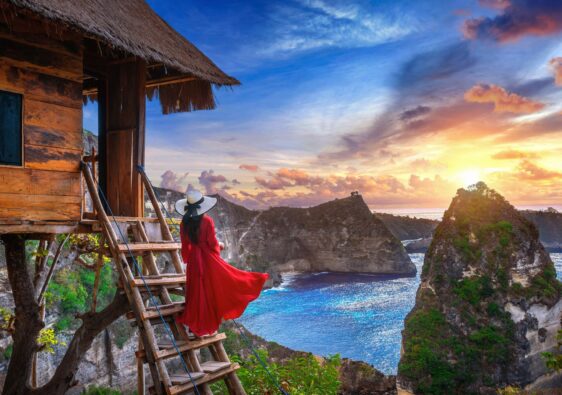
Diamond Beach: The most beautiful beach in Nusa Penida (Bali)
Southern islands: singapore’s hidden paradise, leave a comment cancel reply.
Your email address will not be published. Required fields are marked *
Save my name, email, and website in this browser for the next time I comment.

Traveler’s Guide To The Volta Region, Ghana, Africa
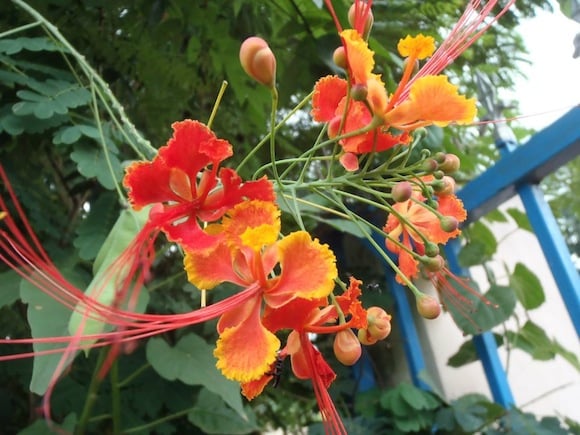
Table of Contents
How To Get There
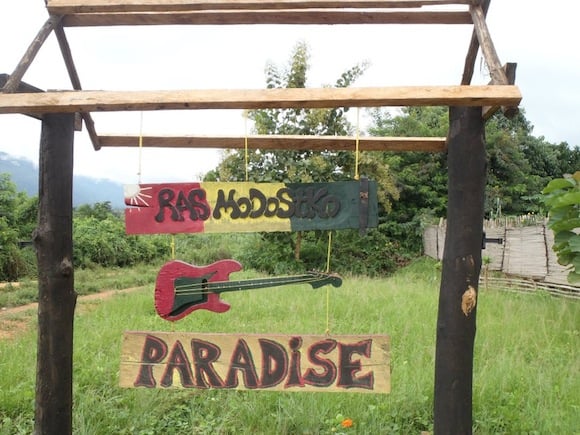
Where To Stay
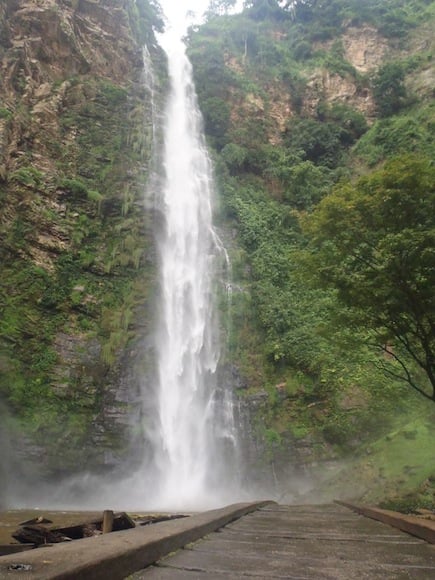
Things To Do
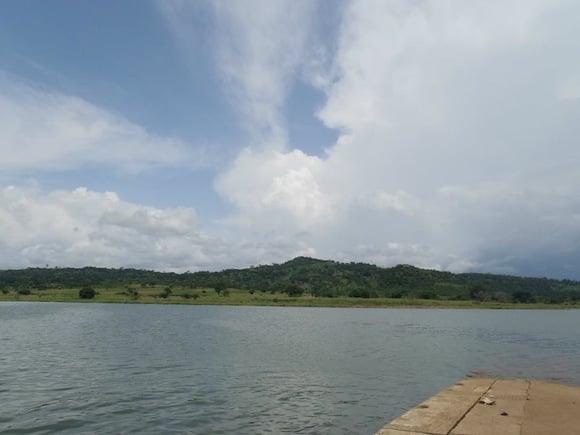
Related posts:

Hi, I’m Jessie on a journey!
I'm a conscious solo traveler on a mission to take you beyond the guidebook to inspire you to live your best life through travel. Come join me!
Want to live your best life through travel?
Subscribe for FREE access to my library of fun blogging worksheets and learn how to get paid to travel more!

Turn Your Travel Blog Into A Profitable Business
Subscribe to my email list to snag instant access to my library of workbooks, checklists, tutorials and other resources to help you earn more money -- and have more fun -- blogging. Oh, and it's totally FREE! :) // Privacy Policy .
Check your inbox for your welcome email + resource library password!
Hi! We are traveling in the volta region in about 2 weeks, and we really wanted to stay at Ras Madesko’s. But we can’t find where it is and how to book it. Do you maybe have more information about that?
Hope to hear from you! Kind Regards, Cato van Lieshout
@Cato: Great to e-meet you! Honestly it’s been so long (~10 years) I’m not entirely sure how I booked it. :/ It was either online or I may have arrived into town and found it. I’m so sorry I couldn’t be of more help, but I do hope you LOVE your trip to Ghana!
Leave a Comment Cancel Reply
The Fascinating Tourist Attractions in the Volta Region
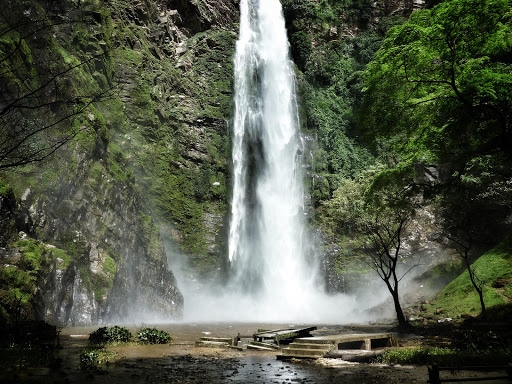
The famous Volta Region is in the south-Eastern of Ghana. It is recognized for its scenic beauty and remarkable tourist attractions. The region has the best natural treasures ranging from rolling hills and valleys to lagoons, rivers, and waterfalls. The Volta Lake is in the east, the Atlantic Ocean in the south, the Oti region to the north, and the Togo region to the west of the Volta region. The Volta Region is recognized for the following features:

Scenic Natural treasures
The Volta Region is a beautiful highland packed with several remarkable natural attractions. It is a glorious region that everybody admires to visit. The key tourist attractions include crystal-clear rivers, stunning waterfalls, Coasts and beaches, and gardens. The famous kente fabric is made in this region. Most people get a chance of hiking the mountains and also see monkey sanctuaries.

Volta region has greatly contributed to the growth and development of the recently established Kyabobo National Park. The Park is situated in the Nkwanta district of the Oti Region, which is 400km from Accra City. Kyabobo National Park is covered by green vegetation, forest, and savanna plants. Buffalo, kob, aardvark, baboon, lions, elephants, bongo, reedbuck, hartebeest, and warthog are the only animals in this park. The Park was set up to enhance the tourism capability of the Volta region.
Also read: The importance of Tourism to Ghana.
Relaxation and Fun
River Volta and Lake Volta are located to the west of the Volta region. Apart from providing power and water for the entire Volta region, Lake Volta is a famous recreational zone. Tourists ride canoes in River Volta guided by the local fishermen. Although not good enough for swimming, Volta has the best beaches in Ghana because the Atlantic coast sea is usually rough. There are several resorts along the coast, where you can easily get your favorite meal in case you are hungry. Tourists get a chance of participating in water sporting, and also deep-sea fishing. Besides, they also get the opportunity of seeing crocodiles and marine turtles. The Wli Falls, Tsatsadu falls at Alavanyo, and the Tagbo falls are the other significant attractions in this region.

The Volta Region is well known for its cheerful festivals accompanied by great ceremonies. The Wli people usually hold a distinctive festival to thank God for the gift of water. The people of Anlos holds a famous Hogbetsotso festival which is a purification ceremony. The purification festival is normally held on the first Saturday of November each year, and it involves cleaning the villages, sweeping the streets, and burning garbage. The Anlos people perform a traditional Borborbor dance, while the chiefs wear Colorful Ceremonial attires and are honored by all the people during the festival’s last day. The Volta Festivals are a symbol of the diverse culture and heritage of these people.
Ho is the capital of the Volta Region, and it offers a great chance to all Tourists who want to learn more about Ghanaian Heritage. The ruins of the European castles and other ancient buildings still exist in this place. Other remains of the German colonial era are there. The regional museum is the ideal place where all tourists can learn all the history of this area.
The Rich Tradition of this Region
The Volta region has several ethical groups such as the Ewe, the Guan, and the Akan peoples. Kente is a famous traditional cloth knit by the Ewe and Ashanti tribes, and it portrays the rich traditions of this region and entire Ghana. Ewe Kente cloth is unique, with bold animal, human and symbolic designs well-knit into bright cloth. It is still a prestigious tradition worn during important religious and social events. Kente Cloth is among the main Ghanaian exports. The climate and the weather conditions of the Volta region greatly vary from coastal plain on the Atlantic coast to arid climate in the north. Most tourists prefer this region because it’s Scenic natural treasures.
The Ghana HIT
The importance of tourism to ghana., the fascinating accra zoo is worth a visit, you may also like, how to stay in budget during a vacation..., choosing the perfect wellness retreat in ghana, a memorable one-week vacation itinerary in ghana, exploring incredible adventures in ghana, things to consider when booking accommodations for holidays, positive and negative impacts of tourism development in..., strategies to solve unsustainable tourism in ghana, exploring the enthralling amedzofe canopy walkway in volta..., exciting tourist hotspots in ghana for your festive..., the impact of globalization on tourism in ghana.
This website uses cookies to improve your experience. We'll assume you're ok with this, but you can opt-out if you wish. Accept Read More

Tourist Sites in Ghana Volta Region
Tourist attractions in volta region.
If Volta Region was a clothe, it would be a "one size fits all" kind of clothe. This is because it has many of the fascinating attributes that other regions of Ghana have. It is like someone copied every other region and pasted it on the Volta Region. The cultural and natural diversity of the place earned it the name "microcosm of Ghana"
Volta Region Destinations
Wli Waterfalls
Quick fun fact: Wli waterfalls is the tallest waterfall in all of West Africa! You have to descend about 250 steps to see the waterfall from below where the fall looks the most beautiful. You will get lost at the sight of fascinating waters splashing in white on the ground right before you before finally flowing away, leaving you astounded and dazzled.
Tafi Atome Monkey Sanctuary
The people of Tafi Atome have a unique way of treating their monkeys. The monkeys are deeply revered by these people because of the traditional significance that is attached to the monkeys. In fact, these people hold funeral rites for dead monkeys before finally burying them in a cemetery that was built for the sole purpose of of keeping dead monkeys. Now, the monkeys are so free with the people so much that they eat from the hands of the people. The Mona monkey is the most prominent monkey species here.
Mount Afadjato And Mount Gemi
Pay a visit to the tallest mountain in all of Ghana, rising to a height of 885 meters into the skies. The second tallest mountain, Mount Gemi is 611meter tall. Mount Afadjato is located very close to Gbledi and Liati Wote near the borders of Togo while Mount Gemi is located at the Amedzofe township.
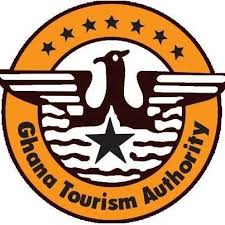
Copyright © 2023 Grassroot Tours. All Rights Reserved.
JOIN THE NEWSLETTER

- About MoTAC
- Management Team
- Directorates & Units
- History & Institutional Memory
- Ghana Tourism Authority (GTA)
- Ghana Museums and Monuments Board (GMMB)
- National Theatre of Ghana (NTG)
- National Commission on Culture (NCC)
- Ghana Tourism Development Company (GTDC)
- Kwame Nkrumah Memorial Park (KNMP)
- W.E.B. Du Bois Centre
- Hotel Catering and Tourism Training Institute (HOTCATT)
- Bureau of Ghana Languages (BGL)
- National Folklore Board (NFB)
- Pan African Writers Association (PAWA)
- National Film Authority (NFA)
- Creative Arts Agency (CAA)
- Tourist Information
- Tourist Sites
- Drama/Theater
- National Register – Intangible Cultural Heritage of Ghana
- Events Calender
- Press Releases
- Right to Information (RTI)
- Publications
Kakum National Park
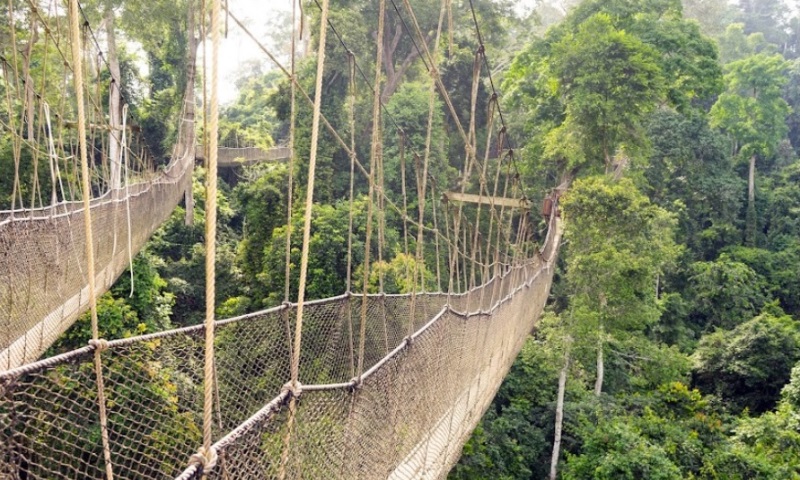
Ghana’s most visited attraction is the Kakum National Park in Assin Attandanso in the Central Region. It has a 333-meter long canopy walkway, suspended up to 27 meters above the forest floor from trees that are over 300 years old. The canopy walk is only one of Kakum’s many delights. There are a variety of trails and guided walks that allow visitors to experience the solitude of the rainforest. It’s also a premier site for bird watchers, with over 300 species including eight species of global conservation concern. Mammals include forest elephant, leopard, bongo, bushbuck and many primates, but game viewing is difficult. Also, more than 600 butterfly species have been recorded. The forest has wild life which can be seen in the night and professional guides are always available to take you on a guided night tour. The park is child-friendly. Kakum is about 4 hours drive from Accra. It is advisable you go by your own pre-arranged transport means. You may also go by public transport and connect from Cape Coast. There is a treehouse for you if wish to stay the night for bird and wildlife watching. There is also an outhouse. There are two cafes at the visitor centre serving basic food, snacks and fresh juices. More Information →
Mole National Park
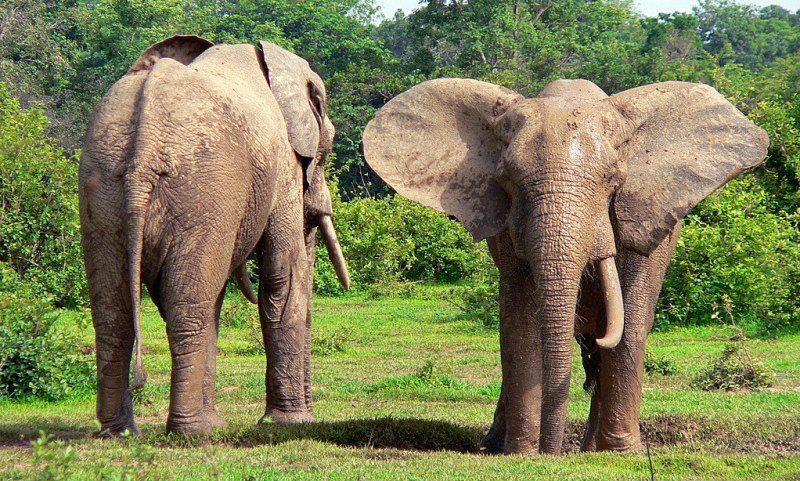
Other Ecotourism Sites and Attractions
Shai Hills Resource Reserve Bui National Park Bia National Park Ankasa Resource Reserve Kogyae Resource Reserve Bomfobiri Resource Reserve Owabi Wildlife Sanctuary Buabeng Fiema Monkey Sanctuary Lake Bosomtwi
Paragliding Festival
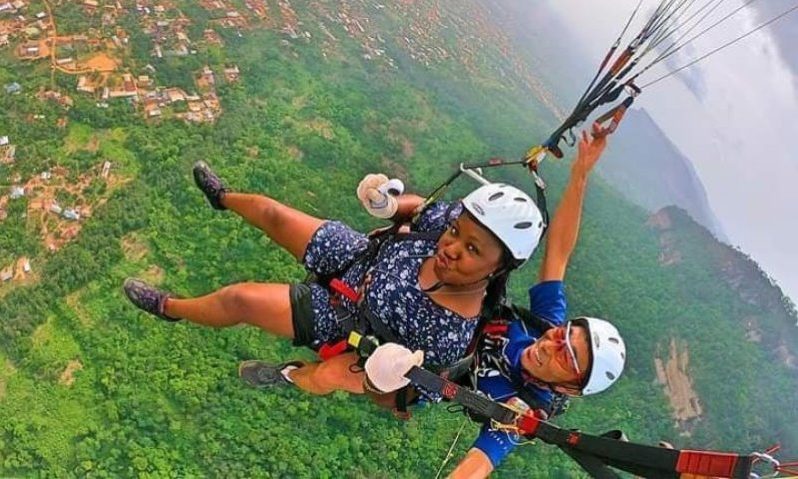
Ghana Paragliding Festival is an annual event held during Easter (usually in April). Seasoned Pilots from around the world are invited to fly hundreds of people during the 3-4 day event at Kwahu Atibie. Pilots with a wealth of experience are selected and coordinated across several parts of the world, in order to cater for the diverse and dynamic nature of participants who come from across the world to fly and have fun. In line with the Tourism Sector’s vision of making Ghana a leading tourism destination in Africa, the Paragliding Festival was instituted to help achieve this goal. The event has over the years flown thousands of people and given them memorable experiences. The 2022 edition promises to be great with tours, hiking and more adventure options. You may drive to Kwahu or get there by public transport via Nkawkaw. The event is held during the Easter period annually in Kwahu in the Eastern region of Ghana. It attracts thousands of tourists from across the world with numbers increasing annually which led to the need for expansion of the take-off point on the Odweanoma mountain. The yearly event which is the flagship programme of the Ghana Tourism Authority organized to promote tourism in the country. At Nkawkaw you can board any of the numerous public transport vehicles climbing up the Kwahu mountain to Atibie. Better still you can hire a taxi from Nkawkaw to the Odweanoma Mountain ( https://goo.gl/maps/mpqqQ9X1BZUbQmms5 )
More Information →
Mountain Afadja
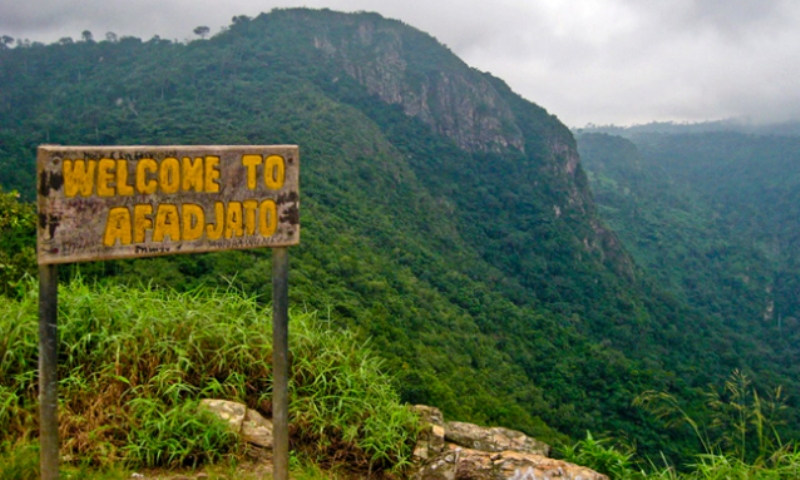
Mount Afadja is one of the highest mountains in Ghana standing at an elevation of 885 metres (2,904 ft). The mountain is located in the Agumatsa Range near the villages of Gbledi and Liati Wote, in the Volta Region of Ghana at the border with Togo. ‘Afadja’ is the name of the mountain whereas ‘to’ in the Ewe dialect means mountain therefore, it is called ‘Afadjato’ by the indigenes. The correct name would be ‘Mount Afadja’ as ‘Mount Afadjato’ will be a repetition of the ‘Mountain.’ Mount Afadja is one of the most visited tourist attractions in the Volta Region of Ghana welcoming thousands of visitors from around the globe annually. About a kilometer (less than a mile) to the east, is the nearby peak of Aduadu, which is higher than Afadjato, also standing at over 900 metres. When the indigenes migrated to the area and saw the mountain it looked like the mound in which water yam is planted, water yam being called “Avadze” in Ewe. Moreover there were some creeping plants on the mountain that resembled the water yam plant; they therefore called it “Avadze-to”. Today the word has been palatalized into “Afadjato”. The nearby Tagbo Falls and Wli Falls (the highest in West Africa) are also considered tourist attractions. There are several hidden attractions of caves, streams and other waterfalls in the area.
Other Adventure Sites and Attractions
Dodi World Legon Botanical Gardens ATV Quad Biking Kakum National Park Bunso Eco Park (Aboretum)
Boti Falls
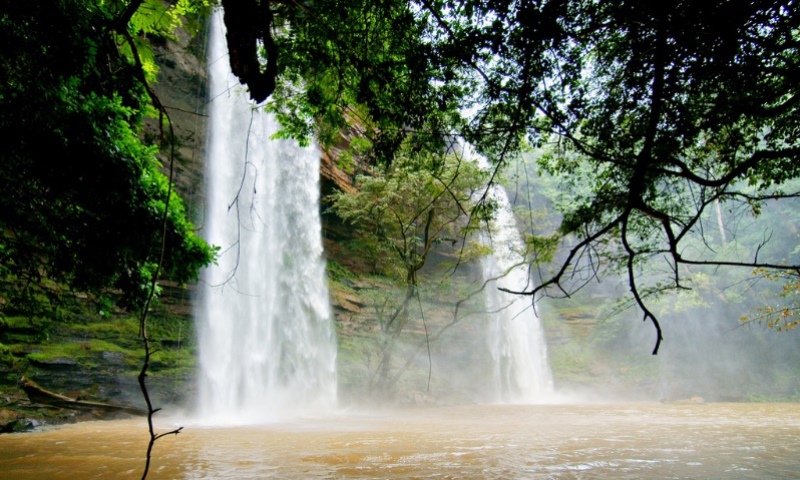
Nzulezu Village
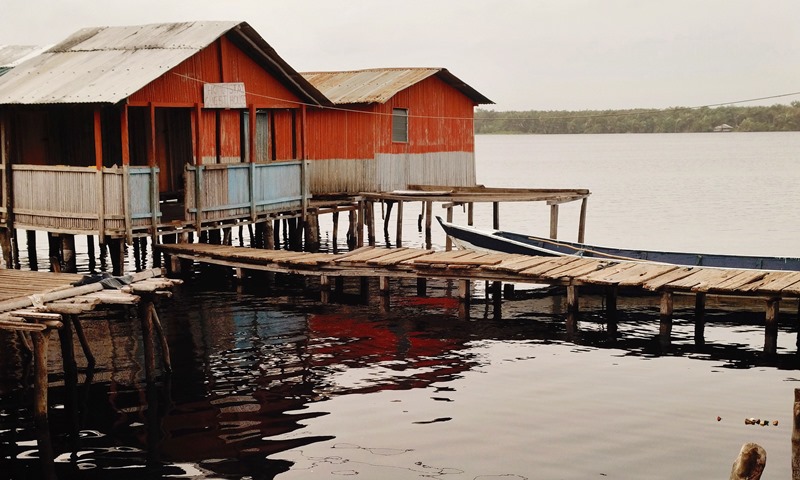
Other Nature Sites and Attractions
Bunso Eco Park (Aboretum) Wli Waterfalls Bobiri Forest and Butterfly Sanctuary Wechiau Hippopotamus Sanctuary
Cape Coast Castle
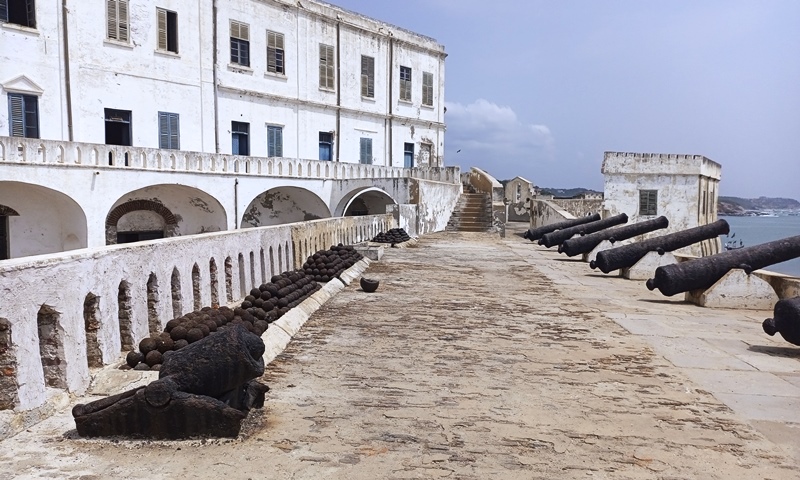
Elmina/St George’s Castle
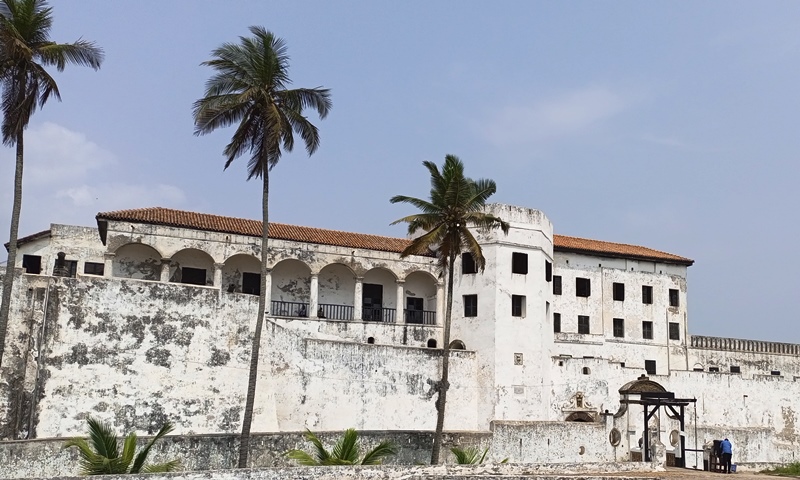
Other Heritage Sites and Attractions
Bono Manso Slave Market World Peace Bell Wassa Domama Rock Shrine Cape St. Paul Light House Fort Saint Anthony Christiansborg Castle (Osu Castle) Fort Orange Independence Arch Fort Apollonia Bisa Aberwa Museum Pikworo Slave Camp
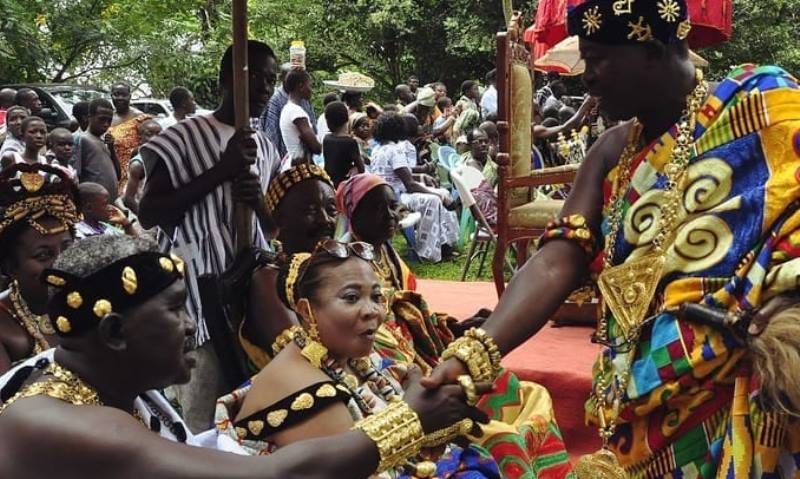
The Odwira Festival is celebrated by the people of Akropong-Akuapim, Aburi, Larteh and Mamfi in the Eastern Region. This festival is celebrated in most Akwapim towns during the months of September and October. The Akuapem Odwira festival was initiated by the 19th Okuapimhene of Akropong, Nana Addo Dankwa I (1811-1835) and was first celebrated in October 1826. It’s significance is to celebrate their victory over the invincible Ashanti army during the historic battle of Katamansu near Dodowa in 1826 and also to cleanse themselves and ask for protection from their gods. Odwira is a time of spiritual cleansing, when the peoples Okuapeman, and all who celebrate, present themselves anew and pray for protection. Traditionally, the timing of the festival also coincides with the harvest season when there is abundant food; during which time the people give thanks to the Ancestors. Being a Yam Festival, gratitude for the harvest is especially expressed in the “feeding the ancestors”. During the Festival, bowls of mashed yam (some mixed with palm oil and others left white) which have been specially prepared by the Okuapehene and other stool occupants are carried in procession from the Ahemfi to feed the ancestors at Nsorem. A little-known fact is, the Odwira Festival is also celebrated by the Ga people of Jamestown in the Greater Accra Region of Ghana as a result of their long association with the Akans through intermarriages.
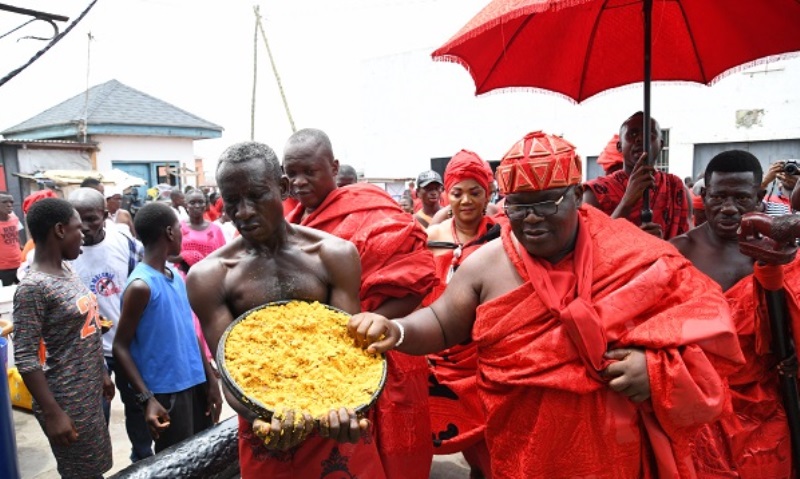
The word Homowo (Homo – hunger, wo – hoot) can mean “to hoot (or jeer) at hunger” in the Ga language. The tradition of Homowo started with a period of hunger leading to famine due to failure of the seasonal rains needed by crops in the Greater Accra Region, where the Ga people predominantly dwell. When the rains returned to normal, the Ga people celebrated by creating the Homowo festival, hence its name and meaning. Homowo is greatly celebrated in all the towns in the Ga state with celebrations climaxing in Gamashie. The celebration begins with the planting of maize, which will be used in preparing the food for the festival named Kpokpoi or Kpekple. During this period, noise making is prohibited or banned since it is believed that it disturbs the gods. The meal is eaten with Palm Nut Soup and it is also sprinkled within the town. This is normally done by traditional leaders and family heads. Celebration includes marching down roads and streets beating drums, chanting, face painting, singing and traditional dances. Even though the celebration of Homowo is a Ga tradition, many other ethnic groups are welcomed to also join in the celebration. The homowo festival of the Ga tribe is believed to have a lineage from the Jewish tribe and its ancestral tradition of the Jewish Passover feast.
Other Culture/Festivals and Attractions
Edina Bakatue Festival Hogbetsotso Fetu Afahye Abeadze Ahobaa Kese

Volta Region – Everything You Need To Know
The Volta Region is Ghana’s most easterly region, bordering Togo. It is a stunningly beautiful place. The rolling hills and valleys, rocky outcrops facing Lake Volta, as well as lagoons, rivers, and waterfalls, are one of nature’s most beautiful gifts to Ghana. The region ranges from the Atlantic coast’s coastal plains to the drylands of the north, with a wide range of weather conditions. From the sun-dappled beaches and mangrove swamps of the coastal plain to the wet deciduous rain forests of the middle belt, where Mt. Afadjato, at 885 meters, is Ghana’s highest peak, to the parched savannah of northern Ghana, you can experience practically every tropical climate in West Africa.
Arguably, the region is one of the best tourist destinations in Ghana. I can say, it is the second-best destination in Ghana for beach vacations while the Western region is the first. If you are in Ghana or now visiting Ghana for the first time, add Volta region to your bucket list since it hosts some of the best tourist destinations in Ghana.
Mrpocu.com has put together a guide to help you know more about the region and visit without any stress. From budget tips, places to visit, and places to eat. This guide is the best you can get on the internet.
After exploring Volta Region for three days, I have worked hard putting this guide together to also help you explore. If you find this article useful, share it with others to help them visit or explore the region without any stress.

Table of Contents
Fact About My Guide
Although the Volta region is not one of Ghana’s largest, it is difficult to wrap your head around it. It’s difficult to produce a book that covers the entire diverse region, but I’ve found a method to make it very simple for anyone visiting the region for the first time or currently living there.
Depending on the season you travel, certain destinations may be a little pricey to stay and explore (Christmas and new year). Even though it can get pricey in some regions, it will have no effect on your budget. As a result, this handbook covers the entire region. Because every portion of the Volta region has something to offer every visitor.
About Volta Region
The Volta Region, with Ho as its headquarters, is one of Ghana’s sixteen administrative regions . The territory, which is divided into 25 administrative districts, is multi-ethnic and multilingual, with ethnic groupings like as the Ewe, Guan, and Akan peoples. The Lolobi, Likpe, Akpafu, Buem, and Nkonya (now part of the Oti area) peoples are among the Guan peoples. In December 2018, this region was separated from the larger Volta Region.
The Volta Region is located in Ghana’s southeast corner and is surrounded on the east by the Volta Lake, on the south by the Atlantic Ocean, on the west by Togo, and on the north by the Oti region. One of nature’s most attractive gifts to Ghana is its environment of rolling hills and valleys with rocky outcrops, lagoons, rivers, and waterfalls.
The Volta Region, which runs from the Atlantic coast’s coastal plains to the drylands of the north, has a wide range of climatic conditions. Traveling from the coastal plains, bordered by sunny beaches and mangrove swamps, via the deciduous rain forests of the central belt—the location of Mount Afadja—to the parched savanna of northern Ghana, visitors can experience practically every tropical climate in West Africa.

What is Volta Region Know For?
The Volta Region is known for its colorful festivals and boisterous celebrations. The inhabitants of Wli celebrate a one-of-a-kind holiday to praise God for the gift of water, while the Anlos celebrate the legendary Hogbetsotso festival (which translates to “festival of Exodus” in Ewe). On the first Saturday in November, a cleansing ceremony is held, followed by several days of village cleaning, street sweeping, and garbage burning.
Locals perform the traditional Borborbor dance at the festival’s conclusion, while chiefs dress in colorful regalia and receive honor from their subjects. The Volta festivals’ joyful dancing and singing serve as a reminder of the region’s great diversity of history and tribal culture.
What Language Is Spoken in Volta Region?
Sekpele (number 53 on the Ghana map) is one of the many languages spoken in Ghana’s Volta Region, according to Ethnologue: Languages of the World (1992, 264). A community called Likpe (Mu) speaks the language north of Hohoe in southern Ghana (ibid., 270).
Volta Region Towns
These are popular places you can see in Volta Region of Ghana
Keta, Hohoe, Kpando, Ho, Aflao, Amedzofe, Abor, Abutia, Adidome, Brewaniase, Gbafi, Nogokpo, Peki, Sogakope, Sokpoe, Weta, Tegbi.

Volta Region Districts
Volta Region is divided into 18 administrative districts namely Adaklu Anyigbe, South Dayi (Kpeve), North Dayi (Kpando, South Tongu (Sogakope), North Tongu (|Adidome), South Ketu, North Ketu, South Nkwanta, North Nkwanta, Ho Municipal, Hohoe Municipal, Jasikan, Kadjebi, Krachi East, Krachi West, Biakoye and Keta.
Transport System in Volta Region
Traditional taxis, buses, minibusses (trotro), and tricycle motors are all available in the Volta region. All of these modes of transportation, particularly the tricycle, are inexpensive. So keep that in mind if you’re on a budget and want to visit the Volta region.
If you’re on a budget, taking the minibusses (trotro) is another good alternative. It’s just a little annoying at first, but you’ll grow used to it.
Taxis are frequently shared. You’ll have to pick and choose among the other passengers, too. If you book or request ‘Dropping,’ however, you will have it all to yourself.
The Vip bus system connects all to other regions from Volta region.
Volta region Festivals
These are top festivals one can attend in the Volta Region of Ghana:

Hogbetsotso Festival
When the Anlo Ewes, an ethnic group on Ghana’s eastern coast, initially moved from Southern Sudan, they are thought to have settled in Notsie, Togo. According to legend, they escaped Ago-Koli, the oppressive ruler of Notsie, by walking backward. The people created this annual “”Festival of the Exodus”” to honor the exodus and the bravery of their traditional kings who guided them on the voyage. The festival is marked by a number of ceremonies, including a period of peacemaking during which any lingering issues are intended to be resolved.
This is a traditional stool cleansing ceremony as well as a period of general cleaning in which the communities are swept and trash is burned. This cleansing ceremony begins at the Volta Estuary and continues for days until it reaches the Mono River in Benin’s Republic. A durbar of Chiefs and people is an important part of the event. Chiefs don ostentatious regalia and sit in state to elicit adoration from their subjects. Throughout the event, there is dancing, singing, and general merriment. The main durbars are held in Anloga, 15 kilometers west of Keta and a two-and-a-half-hour journey from Accra, on the first Saturday of November every year.
Agbamevoza (kente festival)
Every year in August, the chiefs and people of the Agotome traditional territory, a few kilometers east of Ho, who are definitely Ga-Adanbges, hold their annual Kente festivities. By all accounts, this is a one-of-a-kind celebration. People from long ago claim to have introduced the craft of Kente weaving to modern-day Ghana, and as a result, a colorful festival has been held to commemorate the occasion. The event concludes with a durbar of chiefs and subjects, where several types of Kente cloth are displayed.
The Kente-weaving competition is a distinctive feature of the event, and the winner is crowned. Miss “Agbamevor” (Miss Kente) INS was chosen on Saturday evening. Thousands of people from far and wide, including tourists, attend this one-of-a-kind celebration.
Amu (Rice) Festival
The festival is called a harvest festival since it is centered on the rice harvest. It is commemorated in Vane, the Avatime people’s ancestral capital. It is observed from the last week of November to the first week of December.
It does get a large number of visitors. People from the Ahanta districts of the Western Region relocated to Avatime, and their drumming, dancing, and singing represent their battles with the indigenous inhabitants of the land they now call home.
Sasadu Festival
The SASADU festival is held in October by any of the four communities that make up the SASADU, namely Saviefe, Akrofu, Soviet, and Alavanyo (on a rotating basis).
It is a pompous and pageantry-filled festival intended to renew the familial bond that exists between the four communities that are supposed to be descended from the same stock. The occasion is crowned by a great durbar of chiefs.
Dzawuwu Festival
Every February, the chiefs and people of the Agave traditional territory gather in Dabala, their main commercial center, to celebrate the annual Dzawuwu festival. It’s essentially a Thanksgiving celebration in which special dishes are offered to the gods. It also honors the valor of previous Agaves who fought and won numerous wars. It is time to pay respects to those who have passed away and pour libation for the people to renew their allegiance to their rulers.
It culminates with a magnificent durbar of chiefs. There is a lot of drumming and dancing.
Tourist sites In Volta Region

Wli Waterfalls
Wli Falls is the highest waterfall in all of West Africa! You must descend around 250 steps to observe the waterfall from below, where it is most spectacular. You’ll be taken aback by the sight of interesting waters splashing in white on the ground directly in front of you before flowing away, leaving you stunned and astonished.
Tafi Atome Monkey Sanctuary
The residents of Tafi Atome have a unique approach to monkey care. Because of the traditional significance associated with monkeys, these people hold them in high regard. In fact, these folks perform burial ceremonies for dead monkeys before burying them in a cemetery specifically designed to house dead monkeys. The monkeys are now so at ease with people that they eat from their hands. The Mona monkey is the most common monkey found in this area.
Amedzofe Village
At about 600 meters, Amedzofe is the highest livable spot in Ghana, nestled at the foot of Mt. Gemi. Hiking up the mountain and to a beautiful waterfall in the valley is an option for visitors. German missionaries built a church and a bell tower on one of the highest points in the settlement in the 1930s, along with a 4-meter-tall huge cross on top of Mt. Gemi. In clear weather, both the peak and the church site offer spectacular views all the way to Lake Volta.
Fort Prinzenstein
After a fight with the people of Anlo and Keta, the Danes built Fort Prinzenstein in 1784. It is the only slave Fort east of the Volta River, and it served as the hub of the Danish slave trade in Africa.
TAGBO FALLS
Tagbo Falls is a waterfall in Ghana near Mount Afadjato, located at Liati Wote, some 27 kilometers east of Hohoe settlement. The water falls in various phases, the last of which is roughly 60 meters high. The location is encircled by woodland.
Related posts:

Privacy Overview
Adblock detected.

Top 5 Tourist Sites in the Volta Region of Ghana
Enjoy and share .
The Volta Region is one of the regions in Ghana with diverse cultures and people. The region is situated on the eastern borders of Ghana. The Volta Region has a lot to offer in terms of tourist attraction sites. Here are the top 5 tourist sites in the Volta Region:

Afa’ is the name of the mountain and ‘djato’ means hill, so literally Afadjato means Afa Hill or Afa Mountain. Afadjato is the highest mountain in Ghana and rises to an elevation of 885 meters (2,904 ft.).
The mountain is located near the villages, Liati Wote and Gbledi at the Ghana – Togo border. It is found in the Agumatsa Range. The name of the mountain is derived from the ewe word ‘Avadzeto’ which means at war with the bush. It is number one tourist destination for visitors and tourist in the region.
Wli Water Falls

Second on the list, of the top 5 tourist sites in the Volta Region, is the Wli Water Falls. The Wli Water Falls is the highest water falls in Ghana and West Africa. The water falls measures 143 meters’ in height. The local name of the fall is Agumatsa which means ‘’allow me to flow’’. The water falls is found on the same mountain range on which is Afadjato. Wli falls is located 20 meters away from Hohoe.
In reaching the water fall, one will have to walk through the greenery forest which provides a cool breeze, not to mention the 12 small streams one will have to cross.
Amedzofe Township

Another top 5 tourist site in the Volta Region is the Amedzofe township. Amedzofe is a small town located north of Ho, the regional capital.
The township is home to lots of tourist attraction sites and offers an exciting adventure to the, forest, Ote Falls and Ghana’s second highest mountain, Mount Gemi (611m). Another important fact is that: at an altitude of 750m, it is Ghana’s highest settlement. A reported 20,000 visitors and tourists visit the Amedzofe township yearly.
Tafi Atome Monkey Sanctuary

Tafi Atome is home to the Tafi Atome Monkey Sanctuary. It is one of the most well managed eco-tourism sites in the country, and one of the top five tourist sites in the Volta Region. It is home to a population of endemic Mona monkeys which are considered sacred by the natives.
The Monkeys number about 300. The forest is a semi deciduous forest within the savannah transitional zone, with grassland and farmlands. Tourist can play with monkeys, feed them, and take pictures. The monkeys are not aggressive and are very friendly. Tafi Atome is about 80km from Ho.
Holy Trinity Spa and Health Farms

Probably not the tourist site one imagines, but The Holy Trinity Spa and health Farms is one of the top five tourist destinations in the Volta Region. It is located in a serene quite environment, along the Volta River, in Sogakope.
It is a good place for relaxation and holidays. It can cater for programs and activities like: retreats, honey moons, wedding receptions, health vacations and many others. It is definitely a place to cool off and release off some stress. The Spa has boats and jet skis for cruising on the Volta lake.
Interested in travelling and touring Ghana? When are you planning your tour? Are you going alone or with a group? What are your key objectives for this special tour? Let’s help make your tour a great success—we handle everything—from car rental to the tour experience.
Location: Ghana, Accra-Cantonment
Email: [email protected]
Call: + 233 201588455.
Copy short link

Entertainment
- GhanaWeb TV
- Home - Features
- Archived Articles
- Home - Wall
- Club Members
Opinions of Friday, 5 April 2024
Columnist: Joel Degue
Unlocking the tourism potential of Volta Region through AfCFTA
« Prev
Next »
Comments (0)
Listen to Article

The African Continental Free Trade Area (AfCFTA) presents a monumental opportunity for the growth and integration of the African continent. Beyond its economic implications, AfCFTA opens a gateway for cultural exchange, tourism, and the flourishing of the creative arts. In this article, I will explore how Ghana, particularly the Volta Region, can strategically brand and position itself to harness the immense potential of AfCFTA for the development, promotion, and marketing of its tourism, creative arts, and cultural offerings. A Powerful Growing Industry: Global tourism is a multi-trillion-dollar industry. In 2019, the total global tourism industry generated about 9.2 trillion dollars, roughly 10% of the total global economy of about 94 trillion dollars. That's not a small economic sector at all on the global scene. According to statistics, international tourist arrivals in 2019 were about 1.5 billion, with a total revenue of about $2.9 trillion. Africa alone received over 69 million international visitors and generated over 440 billion dollars in revenue. In Ghana, the year 2019 was historic, with the Year of Return hitting home. Over 1.1 million international visitors came to Ghana, the first time Ghana had hit over one million tourists. That year also saw Ghana make total receipts of $3.3 million from international tourist arrivals. If these facts and figures are anything to go by, then AfCFTA presents a far bigger opportunity for Ghana and, for that matter, the Volta Region to leverage on. AfCFTA as a Catalyst for Continental Integration: AfCFTA's primary objective is to create a single market for investment, capital, technology, human resources, goods, and services, promoting free movement of all these and fostering economic collaboration among African nations. This will eliminate trade barriers and protocols, thereby making it easy for the movement of goods and services across the continent. This also creates a conducive environment for tourism, creative arts, and cultural exchange, making it imperative for regions and countries to highlight their unique cultural identities to attract visitors and consumers. Tourism Potential of Volta Region: The Volta Region, endowed with breathtaking landscapes, historical sites, and vibrant cultural traditions, stands as a treasure trove waiting to be discovered. To leverage AfCFTA effectively, Ghana, and specifically the Volta Region, must strategically position itself to showcase the following tourism potentials as the gateway to Ghana: a booming population and a fun-seeking behemoth to the east, Nigeria, and beyond. The region's natural wonders, cultural uniqueness, historical links, and colonial architectural heritage are key attractions for an increasingly interconnected African market and beyond. The region must not only be the land space to cross to Accra and beyond in order to enjoy visiting Ghana. It must be a region to visit too when one arrives in Accra by air in order to really see and claim that one has visited Ghana. Wondrous Landscapes: The Volta Region boasts diverse landscapes and reliefs, from the pristine coastal beaches and serene Volta River and the Volta Lake, the largest artificial lake in the world by land size, to the numerous picturesque waterfalls such as the Wli, Tagbo, and Amedzorfe Falls, to the mountain peaks like Gemi and Adaklu with the highest peak in Ghana, Afadjato, and the luxuriant, moist semi-deciduous forest. These natural wonders present opportunities for water sports, eco-tourism, adventure tourism, leisure, and wellness retreats. The Volta Region can capitalise on these attractions and attract a great number of tourists to the region. Cultural Festivals: The region hosts colourful festivals such as Hogbetsotsoza, Agbogboza, Teza, Sometutuza, Agbamevorza, Gidukorza, Glimetotoza, Apenortoza, Ayimagonuza, Dzawuwuza, Sasaduza, Amuza, Tortsotsoza, etc., celebrating epic and specific events in the history of the various ethnic groups in the region. By promoting these festivals, the Volta Region can attract cultural enthusiasts from across the continent to the region and boost its tourism offer. Historical Sites: With sites such as the Slave Museums at Adafienu and Hedzranawo, the Slave Market at Atorkor, the Slave Home at Ablotsivia/Klikor, the Fort Prinzenstein at Keta, the Cape St Paul Lighthouse at Woe, the German Historical Sites at Kpando, Amedzofe, Kpedze, and Ho, which are all reminders of the region's historical significance in the slave trade, and the colonial links, Volta can attract history buffs and researchers interested in exploring Africa's slave and colonial heritage. Eco-tourism Sites: With the high number of eco-tourism sites in Ghana, the Volta Region can attract nature enthusiasts to the region. Notable eco-tourism attractions include Wli Waterfalls, the highest in West Africa; Tagbo Falls; Tsatsadu Falls; Aflambo Falls; Amedzofe Falls, now with a convoy walkway; Tafi Monkey Sanctuary; Keta-Angaw-Avu Lagoon Complex Ramsar Site; Kalalpa Game Reserve; Kyabobo National Park; Agumatsa Wildlife Sanctuary; and the Volta River Estuary. All these can meet world-class standards and attract thousands of visitors when given the needed attention. Natural Wonders: Volta Region can also boast of some of the finest landforms in its limestone hills, with the formation of stalagmites and stalactites in the form of caves and grottos. Prominent ones are the grottos of Kpando, the ancestral home caves of Likpe, Nyagbo, and Logba, and the caves and iron workings of Akpafu. These are all tourist attractions that the Volta Region can maximise under the opportunities offered by AfCFTA under tourism. Creative Arts and Culture Development: AfCFTA facilitates the exchange of goods and services, including cultural products. To tap into this, the Volta Region can leverage specific areas with comparative advantages, namely: Cultural Exchanges: Establish partnerships with artists and cultural institutions across the continent for collaborative projects, fostering a rich blend of diverse African art forms. This can be made possible through the instrumentality of Ghana embassies and high commissions abroad and those of other African countries in Ghana. Cultural Heritage Preservation: Implement initiatives to preserve and promote indigenous arts and crafts, ensuring the authenticity of the region's cultural offerings. Today, African countries are stealthily losing their cultural heritage through the influence and infiltration of other cultures. Volta Region must seriously guard against the adulteration of its unique culture that has served it until now and be able to present it to the world in its pure and pristine form. Therefore, the wide variety of drum and dance forms in the region must be promoted as performing arts to entertain tourists. The wide variety of sumptuous foods from the region must be promoted too. Promotion and Marketing Strategies: Digital Presence: Develop a robust online presence through dedicated websites and social media platforms, showcasing the region's cultural, artistic, and tourism offerings. This must be professionally done in order to attract the viewership and followership needed to create a buzz about the region's various touristic, artistic, and cultural offerings. Collaborative Marketing Campaigns: Collaborate with other African nations to create joint marketing campaigns that highlight the continent's cultural diversity and draw attention to specific attractions in the Volta Region. Promotional and aggressive marketing campaigns should be pushed through in African magazines and online portals in order to drive the "Volta Brand" and thereby position the region for real business. Infrastructure Development: In order to accommodate the anticipated influx of tourists and enhance the overall experience, the Volta Region should invest in infrastructure development. This includes upgrading transportation and communication networks, ensuring quality accommodations, and establishing visitor centres that provide information on local attractions. There is also a need to train the human resources in the industry to meet international standards. This includes hospitality actors like hotel and resort owners, travel and tour operators and agencies, catering service providers such as restaurants and other eateries, tour-guiding service providers, transport operators, e.g., bus and car rental service providers, and taxi drivers. Sustainable Tourism Practices: In line with global trends, sustainable tourism practices should be integrated into the development plans. Emphasizing eco-friendly initiatives and community engagement not only preserves the region's natural beauty but also appeals to conscientious travellers seeking responsible tourism experiences. This should be done with the local communities that are close to these attractions. These communities should be educated to know that they are part of the tourism sector through employment and income-generating activities in their communities. Therefore, they can and must contribute to making it sustainable. Development of A Comprehensive Strategic Tourism Plan: In order to drive all these ideas to a successful realisation, there is a need for a strategic tourism development plan. This plan should look at a five-year horizon with a goal for tourism in the region, specific objectives, carefully thought-out strategies, a solid action plan, measurable outcomes, an effective monitoring and evaluation system in place, a destination management organization, and a dedicated vehicle to drive the dream to success. The AfCFTA presents a golden opportunity for the Ghana Volta Region to position itself as a hub for tourism, creative arts, and cultural exchange. By capitalizing on its unique offerings and strategically aligning with the goals of continental integration, the region can unlock unprecedented economic and cultural benefits. As stakeholders collaborate to implement these strategies, the Volta Region stands poised to become a shining example of how AfCFTA can catalyse holistic development and unity across the African continent. Through effective, aggressive promotion and marketing, strategic tourism development initiatives, and country-to-country collaborations, the region can become a beacon, attracting visitors and contributing to the broader goal of an integrated and prosperous African continent. It's possible!

What kind of nonsense is this? - Kofi Oduro takes on government over 'dumsor'
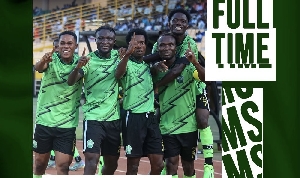
CAF Confederation Cup: Watch highlights of Dreams FC's goalless draw against Zamalek in Cairo

Urban farm vegetables high in mercury, faecal content – Study

I took wrong medication for 8 months - Video of late KODA speaking about his health resurfaces
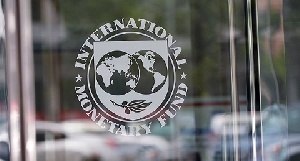
Africa is at a turning point, but economic reforms must be sustained — IMF
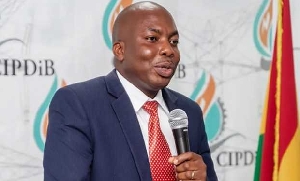
Privatization of ECG is not the solution: A case for sustainable public ownership
- Advertising
- Privacy Policy

IMAGES
VIDEO
COMMENTS
By detravelingfotografa. You need to visit this place to get to know the true background and history of Ghana as well as Volta and Northern pat... 10. Aflabo Waterfall. 2. Waterfalls. By huskybae. Made it to Ghana's Volta region to explore the Aflabo Waterfall. Totally worth the drive to explore.
The sanctuary is a community-based ecotourism project that houses Mona and Patas monkeys. It was founded in 1993 under the guidance of a Peace Corps Volunteer as a community-based ecotourism initiative. It is located in Ghana's Volta region, some 230 kilometres northeast of Accra and 43 kilometres south of Hohoe.
The Volta Region is a lush, highland area full of spectacular natural attractions, scarcely visited coasts and beaches, clear rivers, botanical gardens, and beautiful waterfalls. Visitors can take a trip to the cities of Ho and Hohoe or take the opportunity to see mountains, monkey sanctuaries, and kente weaving villages.
The most easterly region of Ghana, bordering on Togo, the Volta Region is an area of extraordinary scenic beauty. The rolling hills and valleys, rocky outcrops overlooking Lake Volta, and lagoons, rivers and waterfall make for one of nature's most attractive gift to Ghana. ... Attractions. Lake Volta Estuary The estuary is an area of great ...
9. Fort Prinzenstein. 9. Historic Sites. By detravelingfotografa. You need to visit this place to get to know the true background and history of Ghana as well as Volta and Northern pat... 10. Aflabo Waterfall. 2.
Things to Do in Volta Region, Ghana: See Tripadvisor's 1,218 reviews & photos of 28 Volta Region attractions.
Welcome to the Volta Region, a fascinating and diverse destination in Ghana, Africa. Nestled in the eastern part of the country, this region offers an enchanting blend of natural beauty, rich cultural heritage, and vibrant communities. With its stunning landscapes, friendly locals, and abundance of attractions, the Volta Region is a must-visit ...
The Volta Region, located in southeastern Ghana, is known for its stunning natural landscapes, rich culture, and historical sites. ... and private taxis are available for traveling between towns and attractions in the Volta Region. Renting a Car: Consider renting a car if you prefer more flexibility and are comfortable with driving in Ghana ...
Surrounding Volta Lake is a bustling market where you will be able to get food, drinks, clothing and jewelry. There are options to take boat tours of the lake, which you can hire for about 30 Ghana Cedis (about $15.86). Visit The Highest Mountain In Ghana With an altitude of 2,905 feet, Mount Afadjato is the highest mountain in Ghana.
9. Fort Prinzenstein. You need to visit this place to get to know the true background and history of Ghana as well as Volta and Northern pat... 10. Aflabo Waterfall. Made it to Ghana's Volta region to explore the Aflabo Waterfall. Totally worth the drive to explore. 11. White Sandy Beaches.
written by The Ghana HIT December 3, 2021. The famous Volta Region is in the south-Eastern of Ghana. It is recognized for its scenic beauty and remarkable tourist attractions. The region has the best natural treasures ranging from rolling hills and valleys to lagoons, rivers, and waterfalls. The Volta Lake is in the east, the Atlantic Ocean in ...
Pick Volta Region Destinations and create your custom package. Ghana Travel Agency And Car Rental; Ghana +233 54 166 8682; USA +1877 442 6161; [email protected]; ... Tourist Attractions in Volta Region. If Volta Region was a clothe, it would be a "one size fits all" kind of clothe. This is because it has many of the fascinating ...
Mount Afadja is one of the most visited tourist attractions in the Volta Region of Ghana welcoming thousands of visitors from around the globe annually. About a kilometer (less than a mile) to the east, is the nearby peak of Aduadu, which is higher than Afadjato, also standing at over 900 metres. When the indigenes migrated to the area and saw ...
Arguably, the region is one of the best tourist destinations in Ghana. I can say, it is the second-best destination in Ghana for beach vacations while the Western region is the first. ... After exploring Volta Region for three days, I have worked hard putting this guide together to also help you explore. If you find this article useful, share ...
By detravelingfotografa. You need to visit this place to get to know the true background and history of Ghana as well as Volta and Northern pat... 10. Aflabo Waterfall. 2. Waterfalls. By huskybae. Made it to Ghana's Volta region to explore the Aflabo Waterfall. Totally worth the drive to explore.
The Volta Region has a lot to offer in terms of tourist attraction sites. Here are the top 5 tourist sites in the Volta Region: Afadjato. Mount Afajato: Top 5 Tourist Sites in the Volta Region. Afa' is the name of the mountain and 'djato' means hill, so literally Afadjato means Afa Hill or Afa Mountain. Afadjato is the highest mountain in ...
In 2019, the total global tourism industry generated about 9.2 trillion dollars, roughly 10% of the total global economy of about 94 trillion dollars. That's not a small economic sector at all on ...
In 2019, total global tourism industry generated about $ 9.2 trillion dollars, roughly 10% of the total global economy of about $ 94 trillion dollars. That's not a small economic sector at all on the global scene. According to statistics, international tourists arrival in 2019 was about 1.5 billion with a total revenue of about $2.9 trillion.
The Presiding Member (PM) of the Akuapem North Municipal Assembly in the Eastern Region, Asiedu Offei, has urged Muslims and Christians, especially those living in the region, to continue to live ...
9. Fort Prinzenstein. 9. Historic Sites. By detravelingfotografa. You need to visit this place to get to know the true background and history of Ghana as well as Volta and Northern pat... 10. Aflabo Waterfall. 2.